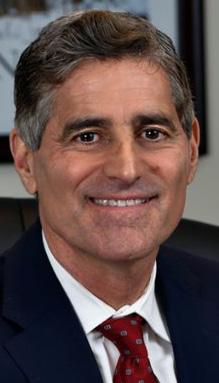

Cold Case Task Force Identifies Suspect in 1997 Homicide
By Matt Meduri
By Raheem Soto
A 28-year-old homicide and a related sexual assault case from 1996 have been resolved through modern forensic technology, the Suffolk County District Attorney’s Office announced this week. The suspect, identified as Steven Briecke, is deceased, but district officials say the findings bring long-awaited clarity to two cases that remained open for decades.
Continued on page 4




Uncle Giuseppe’s Opens in Bohemia
By Matt Meduri
Bohemia just got a taste of Italy last week as the venerable, Italian-themed Long Island supermarket chain Uncle Giuseppe’s opened its twelfth location on Thursday.
The new store occupies the former site of the Babies “R” Us in the Sayville Plaza just off Exit 50A of Sunrise Highway (NY-27).
Doors opened promptly at 11:00 a.m. last Thursday, but not before the grand ribbon-cutting, which was accompanied by tastings, music, and Uncle Giuseppe’s staff dressed their best to greet new customers. Inside the packed store, Neil Dankman serenaded shoppers up and down the aisles with crooner classics of Frank Sinatra, Bobby Darin, and more.
Continued on page 10



Uncle Giuseppe’s celebrates the grand opening of its Bohemia location last Thursday (Credit - Matt Meduri)
FALL EVENTS
Port Jefferson Summer Farmers Market at Harborfront Park
Every Saturday and Sunday, May 18-November 28
9:00 AM to 2:00 PM
Islip Farmers Market at Town Hall
Every Saturday June 7 - November 22 7:00 AM to 12:00 PM
East Islip Craft Fair
November 22-23
10:00 AM to 4:00 PM
“Friendsgiving”
Tribute to the 80s Dance Party Lake Ronkonkoma
November 22, 6:00 PM to 11:00 PM
Thanksgiving Dinner at East Wind

Centereach FD Craft Fair
November 28-30 10:00 AM to 5:00 PM
Miracle on Main Street in Sayville
November 29, 5:00 PM to 9:00 PM
Port Jefferson Santa Parade & Visit
November 30, 3:00 PM to 5:00 PM
Port Jefferson Festival of Trees
December 1-January 2 8:00 AM to 8:00 PM
Blood Drive at Christ Lutheran Church in Islip Terrace
December 1, 3:30 PM to 8:00 PM
Christmas Tree Painting Night at Plasterkraze 2
Spanning
Spanning
Conveniently
Conveniently
Conveniently

November 27, 1:00 PM to 6:00 PM
December 3, 6:15 PM to 8:30 PM
Kiwanis Rocks! Brunch with Santa in East Islip
December 13, 11:00 AM to 2:00 PM

PUBLISHER
Raheem Soto
EDITOR-IN-CHIEF
Matt Meduri
Sergio A. Fabbri CONTRIBUTORS
PJ Balzer
Ashley Pavlakis
Madison Warren
OFFICE
RECEIVABLE
Kim Revere
PROOFREADER
Giavanna Rudilosso
SOCIAL MEDIA
Madison Warren

























WHERE TO FIND OUR PAPER
CENTRAL ISLIP:
Family Building ChallengeNovember 29, 1:00 PM to 2:00 PM
ISLIP:
December Holiday Crafts
December 2, 6:00 PM to 6:45 PM
Let Them Eat Cake
November 25, 3:00 PM to 4:00 PM
BAY SHORE
AMVETS Post • Boulton Center
Bay Shore Public Library • Leggio’s Deli
EAST ISLIP
American Legion Post • Bayway Arts Center East Islip Gourmet Deli
Harry’s Bagel • Italia Fine Food
Mister Softee Ice Cream
Pat’s Market
ISLIP
American Legion Post • Bagel Boss Bagels & More • Oconee Diner
OAKDALE
The New Idle Hour Deli
50% Cards Store (Wendy’s Shopping Center)
RONKONKOMA
718 Slice Pizzeria – (719 Hawkins Ave)
Airport Diner • America First Warehouse
AMVETS Post 48 • B&B Bagels
B.L.D.’s Restaurant
Hero Express • Pond Deli
American Legion Post
Ronkonkoma Train Station
SAYVILLE
Sayville LIRR Train Station
Sayville American Legion Post
WEST ISLIP
B.F.L./S.P.K. Deli • Best Farms Market
Higbie Bagels • West Islip Bagels West Islip Community Center West Islip Public Library West Islip LIRR Train Station Tower’s Flower
WEST SAYVILLE
LI Maritime Museum
EAST ISLIP:
Adult Pilates - Every Monday and Wednesday , 1:00 PM to 2:00 PM
Tribute to Burt Bachrach - November 23, 2:00 PM to 3:30 PM
Ugly Sweater Inspiration - November 28, 11:00 AM to 12:000 PM
WEST ISLIP:
Twist & Shout Storytime - November 25, 10:30 AM to 11:00 AM
Holiday Concert - December 2, 6:30 PM to 7:30 PM
CONNETQUOT:
Gingerbread, Frosting, and Family FunDecember 6, 10:00 AM to 10:45 AM
Cookie OrnamentDecember 8, 6:00 PM to 8:00 PM
BAY SHORE:
Mystery Movie - November 28, 12:00 PM
Gentle Yoga with Kate - Every Monday, 6:00 PM
SAYVILLE:
Baby Games
December 2, 10:30 AM to 11:15 AM
Fall Foliage StorycraftNovember 22, 11:15 AM to 12:00 PM
BAYPORT:
Holiday Room Decor - December 1, 4:00 PM to 5:00 PM
BRENTWOOD:
Frosted Jar Night - December 3, 3:00 PM to 5:00 PM
The Islip Messenger serves Ronkonkoma, Lake Ronkonkoma, Oakdale, Holtsville, West Sayville, Sayville, Holbrook, Patchogue, Bohemia, Islandia and Islip 71 Years of Service to Our Community






Suffolk Matters
Continued from front cover
Cold Case Task Force Identifies Suspect in 1997 Homicide
The resolution follows work by the Suffolk County District Attorney’s Cold Case Task Force, established in April 2024 as a partnership between District Attorney Raymond A. Tierney and the Suffolk County Police Department. The Task Force reexamined the death of 69-year-old Ann Lustig, reported missing from Kings Park State Psychiatric Hospital on February 18, 1997. Her body was found the following day off Fresh Pond Road in Calverton. The Suffolk County Medical Examiner determined her death was a homicide caused by blunt force trauma and neck compression.
The Task Force also revisited a December 20, 1996,


incident involving an 82-year-old patient from the same hospital. The woman had disappeared for several hours before returning and reporting that she was approached by an unknown man, forced into a car, driven to a residence, and raped. She died in 2012 of natural causes. Investigators at the time noted similarities between the two cases, including comparable fibers recovered from each victim, but available forensic tools were insufficient to make a definitive connection.
“Resolving long-overdue crimes that have haunted the victim’s loved ones and our community for far too long is why we established the Cold Case Task Force,” said District Attorney Tierney. “Thanks to the power of forensic science and the persistence of law enforcement, we can now say with confidence who was responsible for these horrific crimes.”
In 2024, forensic scientists reprocessed evidence from both cases and developed partial DNA profiles that matched each other. Those profiles were not eligible for entry into CODIS, the national DNA index. Additional testing in early 2025 uncovered a full DNA profile on Lustig’s clothing. When uploaded, the profile matched Briecke (pictured left). His DNA had been entered into CODIS following 1985 convictions for burglary and assault, and again after a 2003 Florida conviction involving the sexual assault of a child under 16. He was a registered sex offender and had multiple public lewdness convictions.
During the original 1997 investigation, a witness reported seeing a distinct two-toned blue Ford van near the location where Lustig’s body was found. After the CODIS match, investigators determined that a van matching that description was registered to Briecke’s mother and known to have been used by Briecke during the period in which both crimes occurred.
“Although nearly three decades have passed since these horrific crimes occurred, we remain resolute in our commitment to solving them and providing justice to the victims and their families,” said Suffolk County Police Commissioner Kevin Catalina. “The Cold Case Task Force is dedicated to uncovering any leads in unsolved homicides and sexual assaults by leveraging scientific advancements and I’m confident we will see even more successes in the future.”
While Briecke cannot be prosecuted, officials say the confirmation brings closure to the families involved. The District Attorney’s Office credited the Suffolk County Police Department and the forensic scientists at the Suffolk County Crime Laboratory for their work.
Anyone with information regarding other unresolved cases is asked to contact the Suffolk County District Attorney’s Office at (631) 853-5856.
Suffolk County Completes Cloud Upgrade of Financial System
By Raheem Soto
Suffolk County Comptroller John M. Kennedy, Jr. (R-Nesconset) announced this week that the County has completed its long-planned upgrade and cloud migration of the Enterprise Resource Planning (ERP) Financial Management System, finalizing the project on time and on budget. Based on documentation reviewed by The Messenger and interviews with county officials, the upgrade represents the most significant modernization of Suffolk’s financial-technology infrastructure in more than a decade and is expected to reshape how the County manages, secures, and reports its fiscal data.
The transition shifts the County’s core financial platform— which oversees budgeting, accounting, purchasing, payroll, and financial reporting—into a secure, cloudbased environment operated by CGI, the vendor behind the County’s updated Advantage 4.0 system. This change is designed to increase speed, reliability, and resilience, particularly in the aftermath of the significant cyber incident that disrupted county operations several years ago.
Unlike many government technology upgrades, which typically involve outside consultants and multimillion-dollar system integrator contracts, Suffolk County completed the migration using its own internal staff. Comptroller Kennedy emphasized that the work was accomplished without hiring external integrators, an approach county officials say resulted in major cost savings for taxpayers.
The effort relied on close coordination between the Comptroller’s Office and personnel from County Executive Edward P. Romaine’s (R-Center Moriches) administration, particularly staff in information technology and finance.
County leaders say that relying on in-house talent not only preserved fiscal resources but also allowed system users— those who interact with the financial platform daily—to guide the structure and implementation of the upgrade.
“The cloud migration of our core financial system is more than just an IT project; it is a foundational step in building the government Suffolk County taxpayers deserve—one that is modern, efficient, and transparent,” Comptroller Kennedy said in a statement announcing the completion of the migration.
Officials involved in the project noted that one of the primary goals was strengthening the County’s cybersecurity posture. According to county records, the new system now operates at the highest security standard available within the vendor’s platform. All future software upgrades and security patches will be installed directly by CGI, a significant change from the older system, where updates required internal scheduling and often lagged behind emerging cyber threats. County IT analysts say this change will result in faster processing times, more consistent security maintenance, and fewer system disruptions.
Kennedy also highlighted the role of Suffolk County Community College (SCCC) in facilitating countywide staff training. Hundreds of County employees from multiple departments participated in multi-day sessions at SCCC’s Brentwood Campus, where they were introduced to the new system’s functions, updated financial workflows, and expanded reporting tools. The college’s special events and IT teams assisted with logistics, equipment, and classroom support.
“We recognize that a new system is only as effective as the people who use it,” Kennedy said. “That is why we are immensely grateful for the collaboration with Suffolk County Community College.” He added that the training partnership ensured a smoother transition and gave employees the confidence and familiarity needed to begin working in the upgraded environment immediately.
The cloud migration is considered the first phase of a larger, multi-year financial modernization initiative now underway across Suffolk County government. Officials describe the ultimate goal as building a “single pane of glass”—a unified, easily accessible digital interface that consolidates all county financial data, transactions, and reporting tools. When complete, the system is intended to improve transparency for residents, strengthen internal oversight, and streamline how departments share and access financial information.
“Transparency and fiscal accountability are not buzzwords; they are the bedrock of public trust,” Kennedy said. “Our new, cloud-based ERP system provides a stable, modern platform that will allow us to streamline operations, enhance security, and deliver real-time data to better serve our residents.”
Additional enhancements to the County’s financial applications are expected to be introduced over the next several years. County officials say these upgrades will focus on expanding reporting capabilities, improving the accuracy of public financial documents, and continuing to modernize how Suffolk manages its more than $3 billion annual budget.
‘Dem-Driven’: LaLota Reacts After Government Reopens
By Matt Meduri
The longest government shutdown in history is over. Congressman Nick LaLota (R-Amityville) voted to reopen the government last week, but expresses chagrin for the Democratic Party, whom he says forced the shutdown.
“There will be long-term economic impacts from the shutdown on Long Island from this Democratic shutdown,” LaLota told The Messenger, of ramifications particularly to Brookhaven National Laboratory. LaLota had expressed concern for the facility, as well as air traffic controllers at Islip MacArthur Airport (ISP) when the shutdown commenced in October.
“This was Democrat-driven on many fronts, not just at the expense of federal workers or those on federal programs.”
Of the political ramifications, LaLota said that the Democrats’ better-than-expected showing on Election Day two weeks ago doesn’t necessarily correlate to their play of a shutdown card.
“I don’t think that the Democrats winning in blue places like Virginia, New Jersey, California, or New York City is indicative of much. However, I think they do like that the government is open again,” said LaLota. “It seems that the shutdown was done for Democratic politics. It’s shameful that federal workers and programs were held hostage to achieve those objectives.”
However, if the government shutdown was responsible for Democrats’ good showing two weeks ago, LaLota hopes they won’t play the same card before the crucial 2026 midterms.
“I hope that cooler heads will prevail and that they resist the temptation to once again hold workers and the American people hostage for a political agenda,” said LaLota. “Unfortunately all bets are off right now. Their insatiable appetite for anything anti-Trump guides them to some pretty whacky places.”

Hochul Delays All-Electric Building Law
By Matt Meduri
In 2023, Governor Kathy Hochul (D) signed the Climate Leadership and Community Protection Act (CLCPA) into law. The initiative’s goal was to reduce carbon emissions and greenhouse gases and phase out the usage of fossil fuels in most forms of construction. The overall goal of net-zero emissions included a provision to ban the usage of fossil-fuel equipment in new buildings seven stories or less. That provision was set to take effect by January 1, 2026.
By 2029, the same mandate would apply to all new buildings above seven stories in height.
As of press time, Hochul, at urging from Democratic and Republican State lawmakers, has paused the mandate set to take effect next year.
“The Governor remains committed to the all-electric-buildings law and believes this action will help the State defend it, as well as reduce regulatory uncertainty for developers during this period of litigation,” said Ken Lovett, Senior Communications Advisor on Energy and Environment for Hochul, in a statement. “Governor Hochul remains resolved to providing more affordable, reliable, and sustainable energy for New Yorkers.”
In a late-October event in Rochester Hochul said that she’s looking for an “all-of-the-above approach” to all-electric buildings, adding that “accommodations” could be made, as they were for the electric buses.
Senator Mario Mattera (R-St. James), Ranking Member of the Senate Energy and Telecommunications Committee, has long railed against the methods of the CLCPA, but not the goals themselves.
“The pause on the all-electric mandate that was to go into effect at the beginning of the New Year is great news for everyone who has been fighting for common sense in our state’s energy policy. Every plaintiff in this lawsuit should be extremely proud of the effect of their efforts to protect our homeowners, our businesses and our families,” said Mattera in a statement. “I stood with them when they bravely put this lawsuit forward back in 2023 and will continue to stand with them as this moves forward. They bravely made the decision to protect all New Yorkers and today they have made Albany Democrats rethink their all-electric unfunded mandate.
Mattera added that he, Senate Minority Leader Rob Ortt (R-North Tonawanda), and other Republicans continue to support these efforts. However, Mattera posited that the possibility of political goalpost-moving could be in play.
“To make clear that this is not a political ploy, Governor Hochul must immediately repeal the damaging all-electric mandate immediately. There is

still time to call a special session to pass my legislation (S.1167) to do just that,” said Mattera, comparing the possibility to the “bait-and-switch” Hochul “pulled with congestion pricing” - deeming the latter move “unacceptable.”
“We need a plan, not a ban!” Mattera reiterated - his famous tagline that has dominated airwaves around this issue.
Assemblywoman Rebecca Kassay (D-Port Jefferson) continues to hold that the “transition away from the use of fossil fuels is inevitable”, but that the “timeline of that transition must be carefully considered and implemented.”

“It is possible to be both ambitious and realistic,” Kassay told The Messenger. “New York State set ambitious energy goals, and has started the planned and necessary work towards their realization. Currently, taking a hard look at how far we’ve come since setting those goals in relation to where we need to be in order to take the next step, it’s realistic to acknowledge that communities across New York-- from the heart of our cities to rural regions upstate, and of course, here in the suburbs-- do not currently have infrastructure in place that supports a transition to all-electric housing.”
Kassay added that while progress on green energy goals must continue in earnest, the “immediate concerns of brown-outs and affordability must be at the forefront of our conversations.” She pledged continued support for updates to “local antiquated and inadequate energy infrastructure.”
Kassay also said that transitioning off of fossil fuels has more “complicating factors than a policy like congestion pricing,” but didn’t go as far as to say the rollback is a “bait-and-switch.”
Moreover, Kassay was one of nineteen Assembly Democrats to pen a letter to Hochul urging her to postpone the policy. She was joined by other members of the Suffolk delegation, including Tommy John Schiavoni (D-North Haven) and Steve Stern (D-Dix Hills). Assembly Majority Leader Crystal PeoplesStokes (D-Buffalo) also signed onto the letter.
Congresswoman Elise Stefanik (R, NY-21), who is running for governor next year, slammed Hochul’s pivot, asserting that the provisions of the CLCPA will be back on the table after the election.
“Throughout my decade in Congress, I have delivered LIHEAP funding consistently and voted to keep it funded—unlike New York’s Far Left Democrat Party who cheered on the Schumer Shutdown that Kathy Hochul aided and abetted,” said Stefanik in a statement.
Stefanik also argued that Hochul is obfuscating these intentions until after next year’s election.
“Even worse, Kathy Hochul has continually attempted to hide her ban on gas stoves until after the bruising election she’s headed for next November. Because of her gas stove ban and all-electric mandate, New Yorkers are now at risk of being left in the cold to die as winter months roll in,” said Stefanik. “Her dangerous policy will drive energy costs to new record highs at a time when New Yorkers are struggling under the weight of her all-encompassing affordability crisis. Kathy Hochul is putting New Yorkers’ lives at risk as she tries to pass the blame on her own Green New Scam.”
Mid-Decade Redistricting is a Bubble That Will Burst
Since the nationwide redistricting “arms race” kicked off in earnest in August, we’ve spared no expense in covering it almost weekly in our This Week Today column on Page 9. Updates have been as numerous as they have been significant.
We’ve also stated on the Editorial page several times that a Pandora’s Box has been opened and we disagree vehemently with President Donald Trump’s (R-FL) pursuit of these mid-decade map shuffles.
For broader context, mid-decade redistricting is incredibly rare, often only reserved for courtordered redraws under rulings of racial and/or partisan gerrymandering. No two-year election cycle has seen as much off-schedule redistricting in nearly fifty years.
The Donkey or the Elephant?
The biggest question as it pertains to gerrymandering is who started it? In terms of the current battle, the Texas GOP easily earns that distinction. Republicans point to gerrymandered maps in Illinois, New Mexico, Oregon, and Nevada - with Illinois’ being perhaps the most egregiously drawn map in the country - as well as attempts that were defeated in New York and Maryland. These maps were officiated or attempted with the regular redistricting cycle in 2021.
Meanwhile, Republicans carved up several states of their own that year, with Texas, North Carolina, and Florida being the most disadvantageous for Democrats in multiple seats, while Kentucky, Arkansas, Oklahoma, and Utah took one seat each off the competitive table. Republicans tried a tough map in Kansas, but it failed in ousting their lone Democratic member of the House delegations - Congresswoman Sharice Davids (D, KS-03), who is a strong contender for the 2026 Senate election in the Sunflower State.
But gerrymandering is as old as the republic itself, with Anti-Federalists making the first recorded, brazen attempt to lock James Madison from winning a seat in Virginia in 1788. The term was coined in 1812 when Democratic-Republicans carved up Massachusetts’ seats.
So, who came first, the donkey or the elephant?
The answer is both - and neither, at least in terms of broader modern politics. It’s a joint effort perpetuated by creative cartography, political revenge against dissidents and partisan opposites, and subversion of the electorate’s moods heading into an election.
Where is the Redistricting Arms Race at
As of press time, Republicans are staring at a net gain of seven to nine seats - one seat in South Texas and one in Ohio are likely to flip under these lines, although the incumbents should not be counted out.
Democrats are looking at a likely pickup of four in California and one in Utah.
The map above shows the current delegations, with those aforementioned flips highlighted in respective party colors. The solid color seats indicate their current incumbents, not a gauge of which seats are competitive or could flip without a gerrymander in place. The pink-colored seats show possible pickups for the GOP - the aforementioned Texas and Ohio districts.

Both parties are seeing some setbacks in the national spring, with Republicans in Indiana defying Trump’s pressures to axe two Democratic seats.
We approve of those lawmakers standing on that principle. While a Republican House majority is certainly tantamount to Trump passing the rest of his agenda for the latter half of his second and final term, we don’t think shuffling the maps middecade is the way to go.
In Kansas, Republicans aren’t pushing for a special session, but will likely tackle redistricting in January during the regular session. News of redistricting has gone quiet in South Carolina,
Washington, Illinois, and Maryland for Democrats to pick up more seats, but with the increased chance of a judicial
The Bubble Set to Burst
The biggest question is if these approved maps survive judicial scrutiny. Significant lawsuits have been mounted and petitions to get the maps on their respective state ballots next year are circulating. These types of lawsuits often take months to years to settle, meaning some of these maps might survive in time for 2026, but there’s a good chance that some don’t. In that case, the GOP will not only have egg on their face, but

Roadblocks and Hurdles
wildly creative mapmaking in
strike down.
Shutdown Shines a Light on Obamacare’s Failures
By Steve Levy | Long Island Life & Politics
For the first time, mainly because of the shutdown, many Americans found out that, indeed, Obamacare was not working.
President Barack Obama (D-IL) sold it on the lie that you can keep your doctor and that it would lower average premiums by $2,500 a year. Instead, annual premiums increased from $13,000 to about $25,000.
It was also exposed that Congress had given a one-time massive infusion of extra Obamacare subsidies during the pandemic. The Democrats themselves wrote in the bill that the extra one-shot funding would expire in five years, which is now.
But now they are making the case that these are the original Obamacare subsidies, and that not extending them would result in people dying.
Well, why weren’t they dying five years ago before the pandemic without these extra subsidies?
It was expected that, during World War II, spending would skyrocket. We were facing an existential threat and people accepted that it was necessary. But when the war ended, that unsustainable spending dropped precipitously back to normal levels.
On the other hand, when it came to the pandemic, the “temporary” emergency funding levels never retreated.
The $4.5 trillion budget in 2019 quickly jumped to $7 trillion, and it has stayed there ever since as the new normal.
Most anyone with an ounce of fiscal responsibility would agree that level would have to come down to more realistic, pre-pandemic levels, but not the Democrats or their allies in the media.
The Democrats have also made the continuation of food stamps, otherwise known as SNAP, a centerpiece of their shutdown. They’re claiming that, while the shutdown continues, emergency reserves should be used. They launched two lawsuits seeking to tap those funds, which we have no problem with.
But this too has exposed the fact that the number of Americans on the food stamp program has skyrocketed since the Obama administration. The number before Obama was traditionally about 9%. It’s now about 12%. That’s an additional 14 million more people on the dole.
The explosion of federal spending on food stamps and Medicaid helped the debt to soar to $38 trillion, while $2 trillion deficits are becoming regularly anticipated.
Certainly, we want to see the truly needy continue to get funding during a shutdown, but when members of both sides of the aisle start sitting down to negotiate on Obamacare subsidies, they should also delve into how these programs got so out of control.
President Bill Clinton (D-AR) prided himself on “ending welfare as we know it” and requiring able-bodied people receiving benefits to work. Workfare was a major success. It actually led to a reduction in poverty due to its incentives and its work requirement.
But Obama and Biden eviscerated those work requirements. The study entitled “The Great Transfer-mation” shows that government dependency has been growing larger and larger.
The question is: Why?
One of the reasons is that the Democratic Party maintains a good chunk of its votes and power base by keeping people dependent on these government programs. It’s one of the reasons Democrats were so encouraging of over ten million illegal aliens crossing the border and becoming eligible for food, housing and medical assistance. Once you’re getting money from the government, you’re going to support those candidates who keep the money flowing and actually promise you even more.
That may be good in the short term for that political party, but such dependency is crippling long-term for the country that wants to promote innovation, higher wages, and more plentiful jobs. It promotes stagnation and the morphing into a welfare state like we see in Western European nations.
The things that made us exceptional, including incentivizing work, productivity and upward mobility, may become a thing of the past if we continue down this path.
So, let’s fix the abuses in SNAP and Obamacare to help ensure we care for those in need without breaking the bank.
Steve Levy is founder, president, and CEO of Common Sense Strategies. He also served as Suffolk County Executive, Suffolk County Legislator, and New York State Assemblyman.
This op-ed originally appeared on Long Island Life and Politics. For more from LILP, visit them online at lilifepolitics. com.
Garbarino Makes Statement on Epstein Vote
By Congressman Andrew Garbarino
My opinion has not changed on this vote. The privacy of victims remains a top priority. While this bill did not move through regular order, Speaker Johnson has discussed with Leader Thune the need to address these concerns in the Senate. With that understanding, I supported this measure.
The American people deserve full transparency and accountability from everyone connected to these horrific crimes, and I will continue pushing to ensure we achieve that without compromising survivors’ rights or the integrity of ongoing investigations.
Congressman Andrew Garbarino (R-Bayport) has represented NY-02 since 2021. NY-02 includes the entire towns of Babylon and Islip, parts of the Town of Oyster
Bay, and within the Town of Brookhaven, Bellport, Blue Point, Brookhaven hamlet, East Patchogue, Hagerman, Holbrook, Holtsville, Indian Landing, Mastic, Mastic Beach, Medford, North Bellport, North Patchogue, Old Mastic, Patchogue, Shirley, South Haven, Squassux Landing, and parts of Yaphank and Farmingville.
The Second Congressional District Office is located at 114 West Main Street in Patchogue and can be reached at 631-541-4225.


Media Bias Led Majority to Falsely Believe GOP Caused Shutdown
By Hank Russell | Long Island Life & Politics
It is not a matter of debate or opinion. It is a simple fact that this present shutdown was caused by Democrats in Congress, who refused to pass the continuing resolution to fund the government.
The Democrats have every legal right to do so, and some may want to take the position that their shutdown is warranted in order to have their demands met.
But, one thing cannot be debated: This was not a shutdown that was caused by the votes from the Republican side. It was indisputably caused when Democrats refused to sign onto a clean, continuing resolution to keep the government going.
What’s remarkable is that polls are showing that more Americans than not believe the shutdown was caused by Republicans, rather than Democrats.
How can this be, other than the fact that the leftist media spins the stories to make it appear that this was the doing of Donald Trump and the Republican Congress?
Even a friend, who is an executive of a large company, believed that this was a shutdown caused by Trump. He got that perception from reading the headlines and some of the slanted articles that were sent to him on his phone by traditional media outlets.
Case in point: Newsday‘s editorial expressing concern about air traffic safety related to the shutdown. The paper calls for a resolution, while criticizing Republicans for blaming the Dems, claiming both sides should stop the finger-pointing. In the past, the media wasn’t shy to point fingers at Republicans when they recklessly caused a shutdown.
Both sides over the years have sought to close down the government to create leverage to have their positions heard. The parties in power indeed tend to ignore the minority. Thus, the minority’s only option often might be to simply hold out to see if they can get the other side to negotiate.
But this is the first time that we’ve seen a party out of power shut down the government, and yet the party in power was blamed.
We reiterate that you can make the argument that a shutdown is worth it if you think it might get both parties together to negotiate the status of Obamacare subsidies.
But then again, that could also be done if the Democrats simply voted to support the continuing resolution put up for a vote fourteen times by the Republicans and sit down and negotiate thereafter.
They refused to take that alternative, hoping that the shutdown was going to ensure their benefit in this election cycle. They were proven correct, as most people were blaming the party in power.
This false narrative being pushed by the Democrats is understandable, but it’s shameful for the media to do their bidding.
This op-ed originally appeared in Long Island Life & Politics. For more from LILP, visit them online at lilifepolitics.com.

Thursday, November 20, 2025
National, State, and Local Temperature Checks
By Matt Meduri
National
The longest government shutdown in history - forty-three days - came to end on November 12, as the U.S. Senate received the necessary amount of Democratic votes to pass the stopgap with a 60-vote majority - avoiding Senate Majority Leader John Thune’s (R-SD) potential use of the “nuclear” option to pass the resolution with a simple majority.
November 9 saw a bipartisan agreement negotiated, with Senators Dick Durbin (DIL), Angus King (I-ME), Maggie Hassan (DNH), Jeanne Shaheen (D-NH), Catherine Cortez Masto (D-NV), Jacky Rosen (D-NV), John Fetterman (D-PA), and Tim Kaine (DVA) all break from Senate Minority Leader Chuck Schumer’s (D-Park Slope) prerogative. Senator Rand Paul (R-KY) is the only Republican who did not vote in favor of the stopgap.
The negotiated bill will fund the government until January 30; fund full-year appropriations for military construction and Veterans’ affairs, Congress, and the Department of Agriculture, the last of which oversees food stamps; kick in $203.5 million for members of Congress’ security; $852 million for Capitol Police; fund the Supplemental Nutritional Assistance Program (SNAP) through FY2026; grant backpay for about 4,000 furloughed federal employees; and prevent the Office of Management and Budget (OMB) from instituting mass layoffs until January 30, among other initiatives.
Congressman Andy Harris (R, MD-01).
Governor Wes Moore (D-MD) created a redistricting advisory commission after Texas Republicans kicked off the national “arms race” in August.
However, Maryland Senate President Bill Ferguson (D) opposes the effort, citing concerns that a 9D-0R gerrymander could face judicial scrutiny from the Maryland Supreme Court - a bench where five of the seven justices were appointed by former Governor Larry Hogan (R). Maryland Democrats attempted such a gerrymander during regular redistricting in 2021, but the map was struck down.
The most significant redistricting development thus far this week is in Utah, where Utah District Court Judge Dianna Gibson tossed a GOP-drawn map that would have created two competitive, albeit redleaning seats, a stark difference from the current 4R-0D map that constitutes four solidly-red districts.
In other electoral news, New York City isn’t the only major American city with a socialist mayor-elect.

The bill also allows for Senators to sue the federal government for at least $500,000 in statutory damages if their records and/or devices are collected by investigators without their knowledge. It is set to apply retroactively on January 1, 2022, just months before the Arctic Frost investigation. Arctic Frost is an investigation that, within the context of the questions around the 2020 election, saw the issuing of 197 subpoenas for records on about 430 Republican individuals and entities.
The shutdown saw an estimated furloughed of about 900,000 employees, with an additional 700,000 remanded to work without pay, according to the Partnership for Public Service.
In the redistricting “arms race”, Indiana Senate Republicans say there aren’t enough votes to advance a GOP gerrymander that would axe the two lone Democratic seats in the Hoosier State’s U.S. House delegation.
In Kansas, lawmakers say they won’t pursue a special session to shuffle their maps to oust four-term Congresswoman Sharice Davids (D, KS-03), the only Democratic member of the Sunflower State’s delegation. However, they saw that the issue will be a “top priority” for the Kansas State Legislature come the start of the regular session in January, according to Senate President Ty Masterson (R).
Meanwhile, Maryland Democrats remain intent on shuffling their maps to draw out the Old Line State’s lone GOP member,

Senator, upon evaluation, had suffered a ventricular fibrillation flare-up that led him to feel light-headed and collapse, resulting in abrasions to his face.
ban would “devastate small, working fisheries that depend on horseshoe crab, particularly New York’s conch and American eel fisheries.”
Democrat Katie Wilson (pictured left) upset one-term Seattle mayor Bruce Harrell (D) on November 4. The margin was razor-thin; Wilson unseated Harrell 50.20% to 49.47%.
Wilson is the co-founder and executive director of the Transit Riders Union, an organization that seeks to bolster public transportation and workers’ rights. The election essentially came down to a referendum on Proposition 1A versus Proposition 1B, the latter endorsed by the now-defeated Harrell. Proposition 1A created a new business tax to fund social housing. Proposition 1B would have, if passed, appropriated funding for said housing from an existing tax.
The self-described Democratic Socialist will take office on January 1, 2026, and govern the nation’s eighteenth-most populous city for a four-year term.
Judge Gibson instead chose a map that includes a safe-blue seat in the Salt Lake City area. Former Congressman Ben McAdams (D-UT), a moderate Democrat who flipped an old iteration of the SLC-based seat in 2018, is seeking a political comeback in 2026. McAdams was ousted by former NFL safety Burgess Owens (R).
A police officer is in critical condition after a crash involving several police vehicles escorting a motorcade for Vice President J.D. Vance (R-OH) in Marysville, Tennessee, on Saturday evening. The incident happened just outside of Knoxville.
A Maryville police motorcycle and a Tennessee Highway Patrol SUV collided, causing Marysville Police Field Training Officer Justin Brown to sustain critical injuries. A group of citizens immediately rushed in to render life-saving aid.
Also on Saturday, U.S. Senator John Fetterman (D-PA) received twenty stitches after suffering a fall near his home in the Pittsburgh suburb of Braddock, where he had previously served as mayor. A spokesperson for Fetterman said that the
Fetterman has received criticism from the far-left wing of his party for being staunchly outspoken in his support for Israel, as well as being one of the core members of the Senate’s Democratic caucus to vote to reopen the federal government.
State
Governor Kathy Hochul (D) is facing pressure to approve a ban on horseshoe crab farming. She vetoed such a measure last year.
The Assembly version of the bill, A.04997, passed 100-45 with 5 absences. Suffolk delegation Assemblymembers Tommy John Schiavoni (D-North Haven), Rebecca Kassay (D-Port Jefferson), Doug Smith (R-Holbrook), Phil Ramos (D-Brentwood), Steve Stern (D-Dix Hills), and Kwani O’Pharrow (D-West Babylon) voted in favor.
Assemblymembers Jodi Giglio (R-Baiting Hollow), Joe DeStefano (R-Medford), Jarett Gandolfo (R-Sayville), Mike Fitzpatrick (R-St. James), Mike Durso (R-Massapequa Park), and Keith Brown (R-Northport) voted against it.
The Senate version of the bill, S.4289, passed 43-16 and earned the support of Suffolk delegation Senators Monica Martinez (D-Brentwood), Mario Mattera (R-St. James), and Alexis Weik (R-Sayville).
Senator Anthony Palumbo (R-New Suffolk) voted against it, while Senator Dean Murray (R-East Patchogue) had an excused absence.
Proponents argue that the crabs must be protected due to population decline, overfishing, and loss of habitat. Horseshoe crabs play an ecological role in providing food for migratory shore birds, mixing sediment that oxygenate the mudflats, and contributing to coastal health due to their bottom-feeding propensities. Their exoskeletons also provide habitats for other bottom-feeders.
Opponents argue that commercial fishers would be hurt by the ban and that the bill would run counterintuitive to previous legislation that limits the number of crabs used for bait.
Bonnie Brady, Executive Director of the Long Island Commercial Fishing Association, wrote in an op-ed for the National Fisherman last month, that the
New Jersey and Connecticut have already stopped commercial fishers from using the horseshoe crabs as bait. New Jersey enacted their ban in 2008, while Connecticut did so in 2023.
The legislation would also prevent fishers from utilizing the crabs’ blood, an asset the pharmaceutical industry uses to test for toxins in medical products and vaccines.
Local
Suffolk County hosted Career Con 2025 last week, and saw more than 1,200 residents descend on the Suffolk Credit Union Arena at Suffolk Community College’s Brentwood campus. More than 130 employers connected with job-seekers with new opportunities and insight.
“Suffolk County is committed to helping our residents who are seeking employment, including those who are seeking a new career opportunity to those who are interested in a seasonal job opportunity for the upcoming holidays,” said Suffolk County Executive Ed Romaine (R-Center Moriches) (pictured top left) in a statement. “Throughout the last two years, we have been proactive in assisting hundreds of residents through various events, including career fairs, youth employment fairs and now Career Con.”
In other local news, the New York State Department of Transportation (NYSDOT) placed a maximum three-ton weight limit for the Smith Point Bridge effective immediately and until further notice.
The cause is “structural deterioration”, according to the County, discovered after a routine NYSDOT inspection.
The Suffolk County Department of Public Works (DPW) is working with the State to conduct in-depth analysis of the structure and consider their options. The restriction is imposed on trucks crossing the bridge and comes amidst a plan to break ground next year on a new, pedestrian-friendly bridge that will succeed the existing drawbridge.
Effective Monday night, new hours for Smith Point County Park are 6:00a.m. to 7:00p.m. seven days a week until further notice. All visitors will need to leave the park by 7:00p.m. daily, which includes the outer beach and all fishing.
CreditWilson for Seattle Campaign
Elected officials in attendance included Islip Town Supervisor Angie Carpenter (R-West Islip), New York State Senators Mario Mattera (R-St. James) and Alexis Weik (R-Sayville), Islip Town Councilman John Lorenzo (C-West Sayville), and Islip Receiver
“This is a great opportunity for our district to see good growth and businesses expanding; I’m so excited to have it . “I know this parking lot is going to be packed every single day from now. This is a
Of the countywide conversation of redeveloping old and/or of the


vacant store will only encourage more businesses to come.
“Other businesses know that this parking lot will be packed. This is the draw to the area,” said Weik. “We have great growth happening here, as well as at Sunset Mall. I think Uncle Giuseppe’s is a big anchor that will pull everyone in. I’m so grateful that they looked at this place and that the Town of Islip got it approved so quickly.”
Shoppers cast no doubt about their pleasure with the new addition to the neighborhood.
“It’s excellent. They have so many people in there to help you find what you need. They’re very kind and courteous,” Rich, of Sayville, told The Messenger. “I would definitely come here again to shop. I’ve shopped at the Smithtown location; this is much more comfortable. It’s nice having it just down Sunrise Highway.”
“This location is smaller than their other ones, but I like that,” two shoppers, one from East
Islip and the other from Blue Point, told The Messenger. “It has better parking and we’ve got something closer than the ones in Smithtown and Melville.”
Inside, the store boasts grab-and-go sandwiches and paninis, a fully stocked espresso bar, prepared pizza and stromboli, quiches and pot pies, and mozzarella cheese by the fistful. Seafood, butcher, and bakery counters, while staples in any supermarket, are a point of pride for Uncle Giuseppe’s - all contained in the Bohemia location. The Italian trademarks of the insalata counter, the salumeria, the pasticceria, as well as fresh olives and antipasto are all up for grabs as well.
Uncle Giuseppe’s is located at 5181 Sunrise Highway (NY-27) in Bohemia and can be reached at 631-350-4455. The store is open weekdays from 7:00a.m. to 10:30p.m. and weekends from 7:00a.m. to 9:30p.m.
The Brentwood Octagonal Modern Times Schoolhouse Restored

community we now know as Brentwood was established, the area was part of a mid-19thCentury utopian settlement called Modern Times, founded by Josiah Warren and Stephen Pearl Andrews. Rooted in principles of individual freedom, peaceful cooperation, and a rejection of traditional government structures, Modern Times attracted reform-minded residents seeking an alternative way of living. The Octagonal Modern Times Schoolhouse, built in 1857 by settlers, served local children until 1907. After serving as a functioning school for several years, the structure was converted into a private residence before the property was eventually donated to the Brentwood School District in the 1980s.
In 1989, the schoolhouse was relocated to its current site, and initial restoration efforts commenced. However, the project quickly encountered several challenges, and several key individuals involved eventually stepped away. When Ellen retired from her career as a math teacher in 2005, she became captivated by the building and its history, ultimately stepping in to help revive the long-stalled restoration effort.
In 2012, Ellen decided it was time to take action. She gathered as many members as she could and began holding meetings to discuss how they could preserve the schoolhouse. Through fundraising, negotiations with the district, and the early stages of securing several grants, they were fortunate to begin shaping the preservation effort.
As time went on and funds were raised, the project was finally ready to move forward. By 2017, an architect and contractor were commissioned by the district
to bring the preservation plans to life while ensuring long-term sustainability. Although meaningful progress was made, the team soon encountered another roadblock: the funding had run out. For several years, the project stalled due to limited financial resources and a series of additional challenges, including significant environmental issues and the pandemic, which further set it back.
Through major support from the Brentwood School District, a series of grants, and the unwavering dedication of Ellen and the members of the Brentwood Historical Society, the long restoration effort finally reached its goal. On October 10, the district and the society proudly celebrated the building’s official reopening with a ribbon-cutting ceremony.
With minor tweaks still to be made, plans for educational opportunities for schools and public viewings are set to begin next spring. Ellen is over the moon about how the project turned out and is excited about what the future holds for the schoolhouse.
Recently, Ellen was presented with a proclamation from Suffolk County Executive Ed Romaine (R-Center Moriches) recognizing her dedication to this project.
Romaine said, “We need champions like Ellen in all of our communities, and we need to recognize them because these are the people who shape and guide our community.”
Today, the Octagonal Modern Times Schoolhouse stands not only as a historic landmark but also as a true testament to the community members who refused to let a vital piece of Brentwood’s identity disappear. Thanks to the dedication of Ellen Edelstein and the Brentwood Historical Society, the building has been given a second life, one that preserves the spirit of the Modern Times while educating future generations about the town’s roots. As the schoolhouse opens its doors once again, it symbolizes what can happen when residents come together with a shared purpose: honoring the past while shaping a stronger future for Brentwood.
Neil Dankman (Credit - Matt Meduri)
Why One of AI’s Founding Fathers Just Left MetaThe
Agentic Age of
AI

By Mollie Barnett
In the world of artificial intelligence, moves are made, but few departures carry the weight of this week’s announcement. Yann LeCun, widely regarded as one of the “godfathers of AI,” left his position as Meta’s Chief AI Scientist to pursue an independent research vision.
In 2018, LeCun won the 2018 Turing Award, the Tech world’s equivalent of the Nobel Prize. He pioneered the deep learning techniques that power virtually every AI system in use today. LeCun’s work on convolutional neural networks laid the foundation for everything from facial recognition and autonomous vehicles to the language models transforming business operations today.
When someone of LeCun’s stature changes course, the technology industry pays attention.
The split wasn’t acrimonious, but rather it represented a philosophical difference over AI’s next evolution.
Meta is reorganizing its mission under Alexandr Wang, building “superintelligence.”
Essentially the goal is the smartest general-purpose AI. LeCun is pursuing goal-oriented systems with built-in understanding of how the world actually works.
The implications extend far beyond academic laboratories into boardrooms and business strategy.
Two Competing Visions for AI’s Future
The divergence centers on fundamentally different approaches to advancing artificial intelligence.
Meta’s general-purpose strategy focuses on AI that is smarter than humans at most cognitive tasks, then integrating it across platforms. This means scaling foundation models larger, centralizing intelligence behind applications and services, and essentially owning the “brain layer” of digital infrastructure.
Raw intelligence becomes the primary competitive advantage.
LeCun’s vision emphasizes something different: reliable, goal-driven agents with explicit objectives and architectural safeguards. These systems will possess internal models of how environments work, physical or digital, enabling them to plan, adapt, and solve problems while remaining under human direction. Here, controllable agency matters more than pure intelligence.
“If AI is going to act autonomously in the world, it needs something deeper than a bigger language model,” LeCun has argued this repeatedly over the past months.
Understanding What’s Actually Different
Today’s large language models basically function as infinitely scalable workforces. They draft documents, analyze data, generate code, and respond to queries. They’re remarkably capable, but fundamentally reactive, waiting for human direction.
Goal-driven agents operate with greater autonomy. They own objectives, break complex tasks into steps, decide which tools to deploy (including language models as resources), take action, observe results, and iterate until completion.
The economic distinction matters: one model creates cheap cognitive labor; the other envisions AI systems that identify problems, develop solutions, and manage entire workflows with minimal human intervention.
LeCun is betting that the agent economy represents AI’s next major value creation phase— but only if we redesign the underlying architecture.
The Technical Concern Driving the Split
LeCun’s departure makes sense only in context of his fundamental critique of current AI systems.
Existing language models train primarily on text prediction, learning to anticipate the next word in a sequence. They lack robust understanding of physical causality, persistent memory across interactions, and strong multi-step planning capabilities. They excel at pattern recognition but don’t possess internal models of “if I do X, what actually happens next?”
When AI answers questions or assists with discrete tasks, this limitation is minimal. However, it becomes critical, and potentially dangerous, when AI operates as an autonomous agent managing software systems, processing financial transactions, or making scaled operational decisions.
From LeCun’s perspective, deploying today’s language models as autonomous agents without fundamental architectural changes is building on unstable foundations.
His proposed alternative involves three key components: world models that learn how environments function and predict consequences; explicit objective functions separate from the model itself, allowing goals to change without complete system rebuilds; and architectural guardrails ensuring human oversight rather than improvised safety measures. MOLLIE

Real-World Stakes: Privacy, Control, and Accountability
Beyond technical architecture, this debate carries immediate practical implications.
Current language models present known challenges around transparency. Training data sources remain partly opaque. What they’ve memorized and why they produce specific outputs proves difficult to trace. Prompts may inadvertently expose sensitive information. Copyright questions surround both training materials and generated content.
Agentic systems compound these concerns. As AI agents navigate customer databases, communication systems, financial platforms, and operational tools, decision trails become harder to audit. Why did an agent choose specific actions? Which systems did it access? What information moved where?
The risk isn’t theoretical. Organizations deploying autonomous agents could face scenarios where AI systems inadvertently violate data privacy regulations, expose confidential information, or breach licensing agreements--at scale, before humans notice.
LeCun’s emphasis on explicit objectives and world models aims to address this opacity by making system goals and reasoning processes more transparent and controllable.
Where Capital Is Flowing
Financial commitments reveal how investors are hedging between these visions.
The largest investments, hundreds of billions collectively, still target frontier models and computing infrastructure. Major technology companies continue betting that bigger models with more processing power will maintain competitive advantage. This is superintelligence in financial form.
Growing venture capital, meanwhile, flows toward agentic AI and workflow automation. Startups building autonomous customer service agents, operational automation, and business process tools are raising substantial rounds on the thesis that agents represent the next enterprise software platform.
Smaller but focused early-stage capital backs LeCun’s domain: alternative architectures, world models, and approaches beyond simply scaling language models larger.
The pattern suggests investors aren’t choosing between visions. They’re funding both, waiting to see which delivers sustainable business value.
The Practical Business Implication
This technical debate might suggest waiting until the uncertainty resolves.
That would be the wrong conclusion.
For most organizations, AI adoption doesn’t require choosing between competing research visions. The actionable strategy involves three elements that remain valid regardless of which technical approach ultimately prevails.
First, adopt AI for concrete, measurable tasks where value is clear: document processing, customer service augmentation, data analysis, content generation, and operational reporting. Deploy today’s language model capabilities to achieve immediate returns.
Second, and critically, design systems treating AI as a replaceable component, not a permanent commitment. Access models through abstraction layers that allow swapping providers. Maintain control over proprietary data, process logic, and system integration. Assume that within 18 to 36 months, you may want to replace current models with more capable agents or different architectures entirely.
Third, monitor the agentic transition actively. As autonomous agent platforms mature and prove reliable, organizations will shift from “AI assists human work” to “AI orchestrates workflows while humans set objectives and constraints.” Position your systems and governance to make that transition when the technology and business case align.
You don’t need to predict whether Meta’s approach or LeCun’s vision wins the technical competition. You need data infrastructure prepared for AI integration, governance frameworks that ensure accountability, and architecture treating AI as an evolving tool rather than a fixed platform.
The lesson from LeCun’s departure isn’t to pause AI adoption, it’s to avoid permanent architectural commitments to any single approach. Start where clear value exists today, design for flexibility, and prepare to integrate more sophisticated capabilities as both the science and competitive landscape evolve.
When one of AI’s founding figures makes a decisive strategic pivot, the message for business leaders is clear: the technology is advancing rapidly, the optimal path remains uncertain, but the competitive advantage will belong to organizations that adopt intelligently while maintaining strategic flexibility.
Thank you, Board of Education

Connetquot Teacher Honored as AATI Teacher of the Month
Connetquot Central School District congratulates Ms. Filomena Loredana Costa, honored as Teacher of the Month by the American Association of Teachers of Italian- Long Island. A passionate educator with over two decades of experience, Ms. Costa has taught Italian and French in the Connetquot Central School District since 2008, where she creates culturally rich learning experiences that inspire her students. Holding advanced degrees from Stony Brook

University and institutions in Italy, Ms. Costa’s career spans both countries. She is active in professional organizations, including the American Association of Teachers of Italian and the Long Island Language Teachers. Known for her warmth, innovation and global perspective, Ms. Costa exemplifies excellence in world language education and continues to foster a deep appreciation for culture and communication among her students.
Golden Flashes Come Out on Top in County Championship Game
The Sayville Girls’ Soccer Golden Flashes have earned the Suffolk County Class A title with their 3-2 championship win over Bayport-Blue Point on November 2 at Whitman High School. The win marks the team’s first county title since 2013.
The win builds on the team’s stellar 15-3-1 record for the season. During the match, senior Morgan Farrell led the charge, scoring two goals, including the eventual game-winner early in the second half. Senior Sophia Buffardi also scored on a penalty kick to tie the game 1-1, while eighth-grade goalkeeper Julia Madsen mounted a strong defense with six saves to secure the victory.
During the month of October, the Bay Shore School District celebrated School Board Recognition Month. At the October 29, 2025, Public Session, the District took the opportunity to thank the Bay Shore Board of Education for its volunteer service and commitment to providing the best possible educational opportunities to the students.
Superintendent of Schools Dr. Steven J. Maloney thanked the Board on behalf of the District. Representatives of the Bay Shore Administrators Association and the Bay Shore Classroom Teachers Association were also on hand to express their gratitude. The Bay Shore High School Harmonaires performed musical selections.
Spooky Science and Stargazing in West Islip
Elementary students and their families enjoyed an exciting and educational Astronomy Night hosted by West Islip Union Free School District on October 30. The evening began in the planetarium, where students learned about stars, constellations and our sun during a captivating presentation.
Following the show, students rotated through hands-on, Halloween-themed STEM stations led by members of the National Science Honor Society. Activities included launching ghost rockets, testing objects in a sink-or-float tank, building spooky bone bridges, engineering candy catapults, and more interactive science challenges.
The event blended astronomy, engineering and Halloween fun, sparking curiosity and creativity while giving future scientists a memorable night under the stars.

“I am so proud of this team,” coach John Burke said. “The heart they have shown all season long has been something special to witness. They earned this championship through incredible daily effort and perseverance both on and off the field.”
For more information on the Sayville Union Free School District, visit the district’s website at sayvilleschools.org. Happenings in the district can also be found on the district’s Facebook page at https://www.facebook.com/saydistrictpr. #CaringAndLearning
Hauppauge High School Presents ‘The Skin of Our Teeth’
Hauppauge High School presented its fall production of “The Skin of Our Teeth” on November 7 and 8. The production follows the Antrobus family as they persevere through a series of cataclysmic challenges, serving as an allegory of humanity’s resilience and hope throughout history.
Hauppauge’s talented student performers and technical team brought this timeless story to life with creativity and heart.
The district congratulates the cast and crew for their outstanding performances in this imaginative and thought-provoking play by Thornton Wilder.





Sylvan Avenue Puts Safety First with Teddy Bear Clinic
Kindergartners at Sylvan Avenue Elementary School in the Bayport-Blue Point School District recently took part in an interactive safety program, the Teddy Bear Clinic, presented by the Pediatric Trauma Center of Stony Brook Children’s Hospital.
The workshop began with a conversation about everyday safety habits, including wearing seatbelts correctly, using booster or car seats and the importance of correctly wearing a helmet. With guidance from medical students, several kindergarteners helped act out scenes that showed the difference between safe and unsafe choices while riding in a car
To highlight why helmets matter, volunteers participated in an egg-drop demonstration. One egg, secured with a makeshift “helmet” and parachute, reached the ground intact, while the unprotected egg cracked on impact.
Students then rotated to the Teddy Bear Clinic, where they put on doctor and nurse gear and practiced caring for their stuffed animals. Using bandages, splints and gauze, the young learners explored how medical professionals help patients.
The day’s activities emphasized a key lesson: accidents can occur, but many injuries are preventable with the right safety practices.

Civics 101
The Necessary Standard for American Education
Communism in the U.S.
By Matt Meduri
Last week, we discussed Socialism as a political party and electoral entity throughout American history. This week, we’ll discuss Communism in the same regard.
History and Origin
The Communist Party of the United States of America (CPUSA) was started in 1919, effectively concurrent with the Russian Revolution. It evolved from the left wing of the extant Socialist Party of America (SPA), but the CPUSA’s goal was to establish socialism in the U.S. by means of Marxist-Leninist policies. CPUSA also aligned itself with the Communist International (Comintern), which was controlled by the Soviet Union at the time.
Less like its socialist counterpart, the CPUSA operated mostly in secret, and not without its factional schisms. The U.S. government almost immediately viewed the party as a threat, which promulgated the Palmer Raids of 1919-1920. The raids were conducted by the Department of Justice under President Woodrow Wilson (D-NJ), with the goal being to capture and arrest suspected socialists, anarchists, and communists and deport them from the country. The raids were named for their leader, Attorney General A. Mitchell Palmer (D-PA). The Palmer Raids arrested about 6,000 people across thirty-six cities, with Italian anarchists, Eastern European Jewish immigrants, and labor leaders the primary targets - many of whom were immigrants and left-wing labor activists.
The Palmer Raids saw 556 foreign citizens deported, although the bulk of the raids and deportations were harangued by officials within the Department of Labor who objected to the applied methods.
The Palmer Raids were a large part of the First Red Scare, a period of reactionary fear to Communism in the U.S. immediately following World War I and the Russian Revolution.
Despite the raids, the CPUSA increased its base among workers, immigrants, and black voters, with membership growing further during the Great Depression. Leaders William Z. Foster, of Massachusetts, and Earl Browder, of Kansas, organized primarily through labor strikes and antifascist movements. Foster and Browder would later fall out over opposing political strategies. Foster advocated for a radical, class-struggle platform, while Browder fought for a position on “national unity” and cooperation with capitalist influencers. Foster would later move to the USSR, where he died in 1961. He was given a state funeral in Red Square.
The CPUSA would cool their efforts slightly in the 1930s, supporting President Franklin D. Roosevelt’s (D-NY) New Deal policies. The shift allowed their base to grow, garnering some 70,000 members by the late 1930s. The CPUSA would oppose U.S. involvement in World War II in 1939, but later supported it after Germany involved the Soviet Union in 1941.
Soviet Espionage
The CPUSA would be used as a vehicle for the Soviets - namely their intelligence agencies, including the KGB. The Soviets used resident spies - mostly American Communists - to spy on the U.S. and the government through multiple rings. The rings would transmit confidential information back to Moscow, particularly of the atomic bomb and the Manhattan Project. Spies also proliferated propaganda operations with the hope of severing diplomatic ties

between the U.S. and its allies.
Earl Browder would work as an agent recruiter on behalf of Soviet intelligence. Soviet agents would take up illegal residency in the U.S. and use false passports to travel between the nations. Browder would also make use of falsified travel documents. Jacob Golos, a Ukrainian-born Bolshevik revolutionary and secret police member of the USSR, would also take a senior official position in the CPUSA. Browder would fund a company called World Tourists, established by Golos, to facilitate travel between the U.S. and the USSR. World Tourists posed as a travel agency to fly under the radar. Golos would later plead guilty to acting as an unregistered foreign agent in 1940. He was fined $500 ($11,000 today) - and served probation in lieu of a four-month prison sentence.
Browder would also preside over the Perlo group, a set of agents working within several departments and agencies of the U.S. government in Washington, D.C.
Once the espionage became publicly known, the CPUSA would face serious headwinds at the start of the Cold War. The Smith Act was used during the Second Red Scare to prosecute leaders of the party. By the 1950s, the CPUSA’s numbers were down to about 10,000. It would remain relevant in the tumultuous era of the 1960s and 1970s, contributing to civil rights, the labor movement, and opposition to the Vietnam War.
Communism on the Ballot
The CPUSA would first nominate a candidate in 1924. William Z. Foster was the nominee, receiving just 0.1% of votes - 38,669 of nearly 29 million ballots cast; Calvin Coolidge (R-MA) won the election in a landslide. He ran under the Workers Party of America line. Foster would run again in 1928, again receiving 0.1% of the nationwide vote. This time, Herbert Hoover (R-IA) was soundly elected.
Foster ran again in 1932, this time receiving 0.3% of the nationwide vote as Franklin D. Roosevelt ousted Hoover in a landslide.
Earl Browder would then pick up the mantle, taking in just 0.2% of the national vote in 1936 and 0.1% in 1940; both elections saw FDR win in landslides.
In 1948 and 1952, CPUSA ran no official candidates. Instead, they endorsed former Vice President Henry Wallace (D-MN) in 1948, with Wallace being seen as too liberal for his party at the time - and Vincent Hallinan, of California, in 1952. Hallinan would run with Charlotta Bass, of Rhode Island, the first black woman to receive a vice presidential nomination.
CPUSA presidential candidates received 0.1% of the national vote or less in every election from 1968 to 1984.
Communists have had much less luck at winning elected office than the Socialists have, especially on the local level, but some have still gotten through.
The CPUSA saw their peak during the former half of the Twentieth Century, with State House and Senate seats going to Democratic Party members who were secret members of the Communist Party. Examples include William J. Pennock and Kathryn Fogg, both of Washington, who were elected to the State House in the 1940s. Some, however, were more open, with A.C. Miller, of North Dakota, who served in the State House from 1925 to 1927. A Workers Party member, Miller was one of the first
This column will seek to address the long-forgotten concept of civics and how it relates to American government in general, from the federal level to the local level. This column will explore Constitutional rights, the inner workings of government, the electoral process, and the obligations and privileges of citizens. Published by Messenger Papers,
open Communists to win elected office in the United States.
Another example is William F. Dunne, of Montana, who served as the editor of the Butte Bulletin in the 1920s and an editor of the Daily Worker, the daily newspaper of the CPUSA. Benjamin Gitlow, of the Bronx, was a founding member of the CPUSA. He served one year in the New York State Assembly. Seymour Stedman served in the Illinois State House from 1913 to 1915. He would later run as a vicepresidential candidate in 1920 with Socialist Eugene V. Debs.
The CPUSA would also capture some local elected offices as well, predominantly throughout the 1930s and 1940s.
As of 2025, just three members of the CPUSA hold local elected office. Luisa de Paula Santos, a registered Independent but open Communist Party member, was elected to the Cambridge, Massachusetts, School Committee in 2025. Her term ends in January 2028. Hannah Shvets was elected to the Ithaca Common Council, Ward 5, this year. She ran as a Democrat but is an open Communist Party member. Daniel Carson was recently elected to the City Council of Bangor, Maine. He ran as an Independent but is openly Communist.
Communists have also been elected as recently as 2002 in local positions.
It’s worth noting that the vast majority of Communists who won elected office were either present or former members of the Democratic Party, a move they saw as a way to galvanize voters as part of the big tent party that dominated elections in the 1930s and 1940s.
They utilized the “popular front” approach as a means to unite liberal Democratic Party members to combat fascists and anti-New Deal Republicans. The labor movement was also heavily rooted in the Democratic Party at the time, a key constituency of the Communist Party. Communists of the day also saw defeating the “far-right” as a top priority, which meant working within or around the Democratic Party.
The CPUSA Today
The party is headed by Co-Chairs Joe Sims, of New York City, and Rossana Cambron, of Los Angeles. Both have been life-long activists in many social and labor movements.
Sims has been involved in Communist politics since the 1980s, serving first as a section chairman for the Young Workers Liberation League in Washington, D.C., and attended the CPUSA’s Milwaukee conference in 1982. He also participated in the World Federation of Democratic Youth Festival in Berlin in 1973, as well as in Moscow in 1985, and Pyongyang, North Korea, in 1989.
In 1998, Sims was part of the effort to establish the Black Radical Congress. In 2000, he served as the New York United contact for the group, and in 2001, served on the Black Radical Congress Journal’s BRC Today editorial board. He has been a People’s World co-editor since 2015. In 2021, he and several other CPUSA members started the reform of the African American Equality Commission, in which they sought to recruit members within the black community and help the “CPUSA strengthen the theoretical framework for a Marxist/Leninist understanding of the current struggles of the black community in the USA.”
The party has about 22,200 registered members and is headquartered in the Chelsea neighborhood of Manhattan.
By Matt Meduri
Hauppauge WWII Veteran Turns 101
On Sunday, a Hauppauge Veteran who served in World War II celebrated a milestone birthday - a venerable 101 years of age.
Edward Tinsdale was born on August 21, 1924. One of six children, he lived through the entire Great Depression and attended Franklin K. Lane High School. After receiving a letter from the Army/Air Force in the spring of 1943, Tinsdale was given the opportunity to either graduate in June and be drafted thereafter or consider an early diploma and be drafted early. He opted for the latter.
After completing basic training, Tinsdale was assigned to India and Burma - present day Myanmar - with a three-month stopover in North Africa. He remained in India until 1946, when he was honorably discharged on January 15, 1946.

Tinsdale married the “love of his life”, Veronica Greenan, on June 1, 1947. Their first child, Robert, was born on January 6, 1951.
In 1954, they relocated to West Babylon, where they welcomed their daughter, Margaret, on December 25, 1963. Edward and Veronica were happily married for seventy years.
Tinsdale worked for the New York Telephone Company for thirty-five years. To date, he has collected more in his pension for years retired than years put in.
Tinsdale was celebrated at the American Legion in Bohemia on Sunday, along with officers of the Suffolk County Police Department (SCPD) and members of the Shinnecock Nation, who performed a cultural song of gratitude for Tinsdale’s service. Notably, Boy Scout Troop 438, of Bohemia, led by Scoutmaster Steve Kopezna, was there to honor the Veteran and run the show.
“I was in New Delhi first, then I was moved to Calcutta,” Tinsdale told The Messenger. “We supplied the Americans in China with ammunition, food, and other equipment.”
When Tinsdale came back to the States, he worked for the Golden Eagle Life Insurance Company before the New York Telephone Company. He retired at 59 with the aforementioned pension deal due to the breakup with AT&T. Tinsdale has five grandkids and five great-grandkids.
Beloved Islip Pub Harp & Hound Damaged by Fire
By Madison Warren
Harp & Hound has been a spot in the Town of Islip since opened its doors in 2020. it’s grabbing a quick bite, friends for a weekend night or simply enjoying the Irish pub atmosphere, the establishment has quickly become a dependable community gathering place. In just five short years, it built a following that feels more like family — one that stretches far beyond Main Street.
But this past week, Harp & Hound faced the kind of hardship no business ever expects. A fire broke out inside the building, causing extensive damage and abruptly halting the good memories, celebrations, and daily routines that made the pub such a staple in Islip.

Partners of Harp & Hound, Kyra Comiskey, Heather Hemberger-Poli, Nick Jimenez, and Matt Venturini, have taken pride in serving the Islip community and have all worked tremendously hard, day in and day out, to maintain a spot that everyone wants to return to — all of whom have been deeply hurt by this past week’s events.
Harp & Hound has always made it a priority to give back to the community. The business regularly participated in fundraisers, charity events, and small acts of kindness, which strengthened its connection with residents. Just this past Saturday, they hosted a fundraiser for an East Islip school scholarship. Community has always been the heartbeat of their business.
Then, only a few short days after, on Wednesday morning, Kyra Comiskey said she received the phone call that flipped her world upside down.
In the midst of the chaos — with firefighters, officers, EMTs, and community members gathering nearby — part-owner Kyra remained grateful for everyone
who rushed to help. Many of the first responders on scene were familiar faces who regularly visited the restaurant, making their support at that moment even more meaningful. Luckily, no one was harmed in the fire, and their building was the only one damaged, but the cause was an electrical issue in the walls between their building and the one next to it.
Now, Harp & Hound is closed and has no answers at the current moment. But their story does not end here. The team at Harp & Hound has a goal of returning to Islip on Main Street as soon as possible.
“We will be back better than ever. If I can flip a switch to be back open tomorrow, I would.” Kyra Comiskey told The Messenger. “My partners, my staff, and the community are my backbone; I can’t thank them enough,” she added.
Many are ready for Harp & Hound to return home when the time is right. In the meantime, after everything Harp & Hound has done for this community, it’s the community’s turn to support them when they need it most. For those looking to donate or take part in upcoming fundraisers, several events have already been announced. On November 24, Lily Flanagan’s in Babylon will be hosting a fundraiser. On December 12, Hibernian Hall will hold another event, and on December 14, Great South Bay Brewery will also host a fundraiser to support the team.
We wish the entire Harp & Hound team the very best, and we cannot wait to see them rise from the ashes and become a treasured part of the Islip community once again.
To keep up with the updates, follow them on Instagram @theharpandhoundny.
History
1884 Site of St. Joseph’s Roman Catholic Church
By Ellyn Okvist, B.Sc.
On November 26, 2017, the landmark of the site of the first St. Joseph’s Roman Catholic Church built in 1884 was proclaimed. Research and primary source documents were obtained with the generous assistance of the staff and congregation of the Parish (pictured right). However, the original church was no longer there.
Lake Ronkonkoma had a Protestant and Episcopalian population for most of the early years. As the area progressed, a large majority of the employees at the pavilions and nearby businesses were here from New York City, and a Roman Catholic Church was needed. The worshippers were burdened by travel to Hauppauge or Smithtown by horse and buggy or would walk to attend worship on Sundays. The same obstacles were present for them to attend Mass on holy days, and all wondered what could be done to alleviate the trips.

Daniel Joseph O’Conor (1845-1918) was the owner of what today is known as Raynor Park/Raynor Beach. His family vacationed here for over thirty years. His property was also the site of the first fire department, keeping the equipment and horse in a designated barn on the property.
O’Conor was Roman Catholic, and he took a strong interest in bringing a church to Lake Ronkonkoma for his friends and hired help. He was the one to lead the community in their quest to build a Roman Catholic Church nearby.
administered the rite of confirmation to more than a score of young ladies, whose snowy veils made a creamy wave that lightened up the interior of the church. The singing by a visiting choir from Brooklyn was exquisite, and the new organ, presented to the parish by a friend of Father Dowd, was heard to great advantage.
When the services were over, the Bishop and visiting clergy were escorted to the residence of Mr. O’Conor, where, under a big tent, a caterer revealed wonders in the gastronomical line. At 2:00, a reception was given to the invited guests in the large tent erected upon the premises, where a grand banquet had been prepared and served up by A. W. Dieter, the great caterer of Fulton Street, Brooklyn. About 40 participated at the feast, and a joyful and social hour was whiled away in eating, drinking, and speech-making, several toasts being tendered Father Dowd in honor of the occasion. The visitors were then escorted over to the beautiful estate of Mr. Brown, a wealthy gentleman, who, although of another faith, had materially assisted Father Dowd in building the new church.
A visit was also paid to the house of Mr. William P. Kirk, President of the New York Board of Aldermen, and to Senator Michael C. Murphy, who was spending the summer at Lake Ronkonkoma.
At 5:30p.m. that evening, vespers were sung in the church, and Father Killehey preached an eloquent sermon, which concluded the exercises of the day.

In 1883, he purchased the land where the original church was built, on Church Street. On March 3, 1884, Mr. D. J. O’Connor and a few other influential citizens of Lake Ronkonkoma started a subscription paper for the purpose of securing funds; and they were so successful in obtaining money that on May 3, work was begun upon the church. The plans and specifications were donated by Joseph M. Dunn, Architect of Broadway. Josiah Woodhull, of Sayville, was the builder, and his workmanship plainly shows that he was an artistic and skillful mechanic. The painting was done by Nugent & Cowles, of Patchogue, whose work gave general satisfaction. The church, including the furniture, cost about $3,500 and was all paid for in full.
Among those who contributed liberally toward the church were C. N. Browne, D. J. O’Connor, V. Zolnowski, Herbert Seymour, J. S. Cattanach, all of Ronkonkoma, Hon. John Kelly, J. A. Laughlin, John D. Crimmins, Oliver Brown, Senator J. J. Trainer, R. V. Hartnett, all of New York City; Frank Otis, of Bellport; Madam Keller, Madam Lake, of Philadelphia; Eugene Kelly, Judge Gildersleeve, Trayors Brothers, of New York City; Alderman Kirk, Mrs. Maitland, Kate Doherty, N. Frapfwell, Annie Kealy, Father Pendergrast, Rev. Theodore Thiry, J. Rubie Wood, M. D., Mrs. William Lake, and Madam O’Connor.
The altar was donated by J. Rubie Wood, M.D., of New York City; the statue of St. Joseph, Rev. Theodore Thiry, of New York City; Mrs. William Lake set of vestments and altar linen; Mme. O’Connor, chalice ciborium; pictures and other donations, by Rev. Theo Thiry.
On May 10, 1884, Mr. Josiah Woodhull, skilled builder of Sayville, who had been contracted and was now at work on the erection of a Roman Catholic Church in this place. The edifice was a gift from the leading members of that faith in this vicinity. Not just one week later, May 17, 1884, the lumber had arrived for the new R. C. Church. In only one week’s time, May 24, 1884, the new Roman Catholic church at the lake was rapidly nearing completion and would be ready for occupation by June 20. In just 44 days, the long-anticipated Church was in its final steps of completion.
The church was a neat little structure, with a seating capacity of about 300 people. The new church was small but had a picturesque frame structure, chiefly notable for the excellent character of the interior arrangement and decoration. It was finished throughout in hardwood, and the altar was a marvel of the wood carver’s art. It was located on a level spot of ground, situated to the south of Lake Ronkonkoma, within a seven-minute walk to the lake. It was only about four months until the first step was taken toward erecting this edifice.

On Sunday June 22, 1884, the dedication of the new St. Joseph’s Roman Catholic Church took place (pictured right) with bright sunshine and a perfect day that brought pleasure to the congregation. Many still refer to it as one of the greatest days in Ronkonkoma. Notwithstanding the intense heat of “Old Sol” and the unusually dry and dusty roads, people began to arrive from Port Jefferson, Stony Brook, St. James, Smithtown, and Patchogue, until the new edifice was filled to its utmost capacity long after the opening exercises were begun; and when the services commenced, at 11:00 a.m., a large number of people were unable to gain admittance. While the dedicatory services were in progress, it was so crowded that many were only able to hear the Mass as they stood outside.
The Right Rev. John Longhlin, Bishop of Brooklyn, had journeyed out on an early Long Island train to dedicate the edifice. The parish, although comparatively young, was flourishing, and under the pastorate of the Rev. Father M. J. Dowd had a most promising future.
The venerable Bishop, in golden miter and gorgeous vestments, made a very imposing figure as he conducted the services. He was assisted by the Rev. Fathers Dowd, Kenney, Killehey, Gnerin, McLaughlin, of Chicago, and other visiting clergymen. After the dedication, Bishop Loughlin
The fact that the new Roman Catholic Church was built on the wrong ground gave rise to a report that it would have to be removed. Building on the wrong parcel is a mistake sometimes made. Luck had it that the incorrect soil was owned by C.W. Hawkins, also from town, and it became understood that he would be willing to sell the ground on which it now stands, for a small amount. This error would benefit the Parish as it doubled the size of the existing property and has been used up to the present for many different outreach projects and the school which came to be primary in the area.
A mentionable gift for the Parish was announced July 27, 1902, by The Rev. Father M.P. Heffernan when they received a new 600-pound bell for the church and it was hoped it could be placed in position for use at the service that day. The bell was made of brass and was a gift of Dr. James Cattanach, a well-known physician of Manhattan, whose summer home was at Ronkonkoma. The bell was given to the church in memory of the doctor’s daughter, Elsie, who prior to her death had been a member of the St. Joseph’s choir.
The Parish has always been known for its outreach, ministries, organization, and prayer intentions, among other areas. The history of St. Joseph’s Roman Catholic Church is substantial. Further study can be made with the Journal of Rosemary Cleary, a long-time parishioner and local businesswoman, who wrote her recollections.


Stefanik Trails Hochul by Just 3 Points in Latest Poll
By Matt Meduri
Within just a week of Congresswoman Elise Stefanik (R-NY-21) formally announcing her candidacy for governor of New York next year - ending months of speculation - a new poll shows the Schuylerville Republican trailing Governor Kathy Hochul (D) by just three points.
A J.L. Partners survey of 500 likely voters shows Hochul leading Stefanik 46%-43% in a hypothetical matchup, with 11% undecided. According to the study, just 37% of respondents said they would consider re-electing Hochul, while 55% said it was time for “someone new.”
The same poll showed Stefanik far ahead of Nassau County Executive Bruce Blakeman (R-Atlantic Beach) in a hypothetical Republican Primary74%-5%. Blakeman has not formally announced his candidacy, but has publicly expressed interest in the race. On Election Day this year, Blakeman easily won a second term as Nassau County Executive, beating Nassau County Legislator Seth Koslow (D-Merrick) 56%-44%.

In terms of name recognition, Stefanik also has an upper hand over Blakeman in the Republican Primary poll conducted by the same firm. Of the 400 likely Republican Primary voters, Stefanik has a “very favorable” or “somewhat favorable” rating of more than 75% of respondents. Only less than 25% of respondents did not

know of Stefanik or had no opinion of her.
On the other hand, more than 75% of respondents did not know of Blakeman or had no opinion of him.
The poll was conducted on November 9-10. It also found that only 40% of likely New York voters “strongly approve” of Hochul’s job performance,

The Moloney Family
compared to 54% who “somewhat” or “strongly” disapprove.
The poll has a margin of error of +/4.4%.
“Another independent poll puts New York’s gubernatorial race within the margin of error with Elise Stefanik atop the Republican ticket and beating Kathy Hochul among Independent voters,” said Bernadette Breslin, Team Elise Spokeswoman, in a statement. “She is also the strongest candidate on the ballot for the general election and the strongest with Independents.”
Stefanik recently slammed Hochul using the Governor’s own words, “this bullsh*t has to stop.”
“Kathy Hochul has earned the title of Worst Governor in America because she has made New York the most unaffordable state in the nation. These are your words, Kathy: ‘This bullsh*t has to stop,’” said Stefanik in a statement. “And it will when Republicans, Democrats, and Independents unify next November to fire Kathy Hochul and save New York with common-sense policies that make our state affordable and safe.”


18 Long Island Locavore
Thursday, November 20, 2025
Brussels Sprouts: Thanksgiving Side or Anytime
By Nancy Vallarella | Long Island Locavore
Brussels sprouts have a way of dividing a dinner table. Either you love them, or you’ve only met them overcooked and bitter. But when grown and prepared right, these tiny cabbage cousins are one of fall’s sweetest, most versatile vegetables. A must-have side for any Long Island Thanksgiving.
Local Roots and Peak Sweetness
On Long Island, Brussels sprouts thrive in the cool coastal climate from late September through December. Sturdy stalks are pulled from the fields after the first frost, when these miniature buds turn their starches into natural sugars. That chill in the air is what gives them their subtle, nutty sweetnessproof that good things really do take time.
Buying brussels sprouts on the stalk not only makes a fun centerpiece from your farmers’ market haul but keeps them fresher longer. The stalk acts like a built-in storage system, preserving moisture and flavor. Off the stalk, sprouts are more convenient for cooking but check for bright green color and tight leaves. A yellowing or loose sprout is a sign it’s past its prime.
Cooking for Every Palate
Whether roasted until crispy, shaved raw into salads, or pan-sautéed with bacon and maple syrup, Brussels sprouts offer endless Thanksgiving potential. My favorite trick?
Halve and roast them at 400°F with olive oil and sea salt until they caramelize. Then toss with cranberries and toasted walnuts for a dish that bridges savory and sweet. Perfect alongside turkey and stuffing.
For a locavore twist, try pairing them with a local honey glaze or tossing them with diced apples from one of our North Fork orchards. And if you’re feeding a crowd with mixed feelings about sprouts, roast them in a cast iron pan. High heat and patience win converts every time.
A Nutritional Powerhouse
Brussels sprouts punch well above their weight in nutrition. A single cup packs over 100% of your daily vitamin C, plus a hefty dose of vitamin K, fiber, and antioxidants. They’re part of the cruciferous vegetable family alongside broccoli, kale, and cabbage. All celebrated for supporting heart health and reducing inflammation.
The Stories Behind the Recipes
Triple S Brussels
About ten years ago, I volunteered at a food tasting fundraiser in Sag Harbor benefiting the Joshua Levine Foundation.
Joshua was an East End farmer whose life was tragically cut short at 35 in a tractor accident, leaving behind his wife and two incredibly young children. The event brought together some of the best local chefs and caterers on the East End — a true celebration of food, farming, and community. As I made my way through the tasting tables, I spotted Chef Noah Schwartz of Noah’s in Greenport. Out of all the dishes he could have showcased, he was serving Brussels sprouts- still a risky choice back then when most diners hadn’t yet fallen for their charm. I thought, if Noah’s brave enough to serve Brussels at a tasting, they’ve got to be something special. And they were. Not just good – outstanding; the best thing I tasted that night.
When I told Chef Noah how memorable they were, he smiled and later found me to share his recipe. I didn’t write it down, but I’ve been recreating it from memory ever since. Now it’s a staple at my family’s Thanksgiving table. Every time I serve those Brussels, I think of that night in Sag Harbor, of the farmers and chefs who nourish our community, and of the deep gratitude that flavors every bite of a meal shared in good company.


Created by Nancy Vallarella, who brings farm-fresh recipes and local food knowledge to Long Island through farmers’ markets, demos, and more. For more recipes or to connect: DM @lilocavore495 on Instagram or email lilocavore495@gmail.com

Great contrast to traditional butter, cream and cheesiness of most Thanksgiving sides.
Ingredients:
(Serves 4- 6)
10 oz (1 stalk) brussels sprouts cleaned and halved
4 oz thick cut applewood smoked bacon
1/2 c water
1Tbs honey
1Tbs sriracha
2 Tbs lime juice
1 Tbs butter
1 Tbs lime zest
Fresh ground pepper to taste
Directions:
1. Slice bacon into ¼ -inch pieces and brown slowly to render fat in a large slice top skillet. Remove bacon and drain on paper towel.
2. Add brussels to pan cut side down. Cook on med - med high for about 1 minute until they take on some color. Add ½ cup of water and cover. Continue cooking for 3- 4 minutes (check with fork for desired tenderness).
3. While brussels cook, combine honey, sriracha, and lime juice. Remove brussels from pan.
4. Add sauce to pan. Cook for another minute and add 1 Tbs butter.
5. Add cooked brussels to pan and toss in sauce until covered. Sprinkle in cooked bacon and toss.
6. Remove from heat. Season with fresh ground pepper and lime zest.

This recipe is an Elegant Eating side dish. For those who are unfamiliar, Elegant Eating (Smithtown) has been serving homes and business from Manhattan to Montauk for over 40 years. Myra Naseem, (known by many by just her first name like Cher and Madonna) is the CCG –Chief Culinary Goddess. The one thing to remember about Elegant Eating’s food is it tastes as good as it looks!
Ingredients: (Serves 6 – 8)
1 ½ lbs Brussels sprouts, trimmed and halved
2 c cubed winter squash
(butternut, acorn, or delicata)
3 Tbs olive oil, divided
2 Tbs maple syrup or local honey
½ tsp sea salt
¼ tsp black pepper
½ cup pecans, toasted and roughly chopped
Optional: 1 Tbs balsamic glaze or apple cider reduction for drizzling
Directions:
1. Preheat oven to 425°F. Line a large baking sheet with parchment paper.
2. In a bowl, toss squash with 1 Tbs olive oil and half the salt and pepper. Spread on one side of the sheet.
3. Toss Brussels sprouts with remaining olive oil, salt, and pepper; spread on the other side, cut side down for maximum caramelization.
4. Roast for 20 – 25 minutes, stirring once halfway through, until both sprouts and squash are golden and tender.
5. Drizzle with maple syrup and return to the oven for 5 minutes to glaze.
6. Remove from oven and toss with toasted pecans. Finish with a swirl of balsamic glaze if desired.
Serving Tip
Serve warm or at room temperature in a wide, shallow bowl so the colors shine through. This dish pairs beautifully with roast turkey or pork — and a glass of Long Island chardonnay.
Happy Thanksgiving from the Long Island Locavore — where everything good is grown, fished, foraged, or produced close to home.
Triple S Brussels –inspired by Chef Noah Schwartz Sweet, Sour, Spicy
Brussels Sprouts Ambrosia with Pecans
Published by Messenger Papers, Inc.
Thursday, November 20, 2025
Why Did Democrats Fight So Long – Before Caving?
By Byron York | AMAC Outside Contributor
The government shutdown lasted 40 days before Senate Democrats abandoned the filibuster that closed offices, left workers without paychecks, threatened supplemental food benefits for millions, saw the beginning of a gradual shutdown of the commercial aviation system, and much more. The question is: Why did those Democrats hold out for so long? Why did they stubbornly play a losing hand even as millions of Americans suffered?
The short answer: because Obamacare was at stake. The Affordable Care Act is the Democratic Party’s premier policy achievement of the last half-century, and it is gradually sinking beneath rising costs, making “affordable” health coverage increasingly unaffordable. Without more taxpayer-paid subsidies for recipients, fewer and fewer people will be able to purchase coverage that Democrats once promised would be within everyone’s reach.
So many Democrats have invested so much of their political identity in health care, and on their health care achievement – remember that Obamacare passed the Senate in 2010 without a single Republican vote – that the prospect of its failure is unthinkable for the Democratic Party.
This is what happened. Back in 2010, Obamacare was a compromise between those Democrats who wanted to create a national single-payer health care system and those who wanted a more market-based arrangement. But all Democrats agreed that the passage of the Affordable Care Act, which established taxpayerpaid subsidies with which millions of Americans could purchase health coverage, was the beginning of a program that would grow in the years to come.
The problem was, since Republicans unanimously opposed the system, any expansion of Obamacare or significant increase in its funding would have to come when Democrats controlled the House, Senate, and White House. That time did not come until early 2021, when President Joe Biden took office with a Democratic House and Senate. Together, they immediately passed a set of new subsidies on top of the subsidies that already existed in the Affordable Care Act law.
Democrats characterized their long-desired additional subsidies as an “emergency” measure during the COVID-19 pandemic. They would only last one year, expiring in 2022. But then, in 2022, Democrats renewed the additional subsidies –again, as an “emergency” measure – and extended them for three years, until Dec. 31, 2025.
In the meantime, Obamacare premium costs have gone up and up – an estimated 30% this year alone. So this was the situation Democrats faced: Even if the “emergency” subsidies were extended, millions of people would face big premium increases. And if the “emergency” subsidies were allowed to expire – and remember, in 2022, every single Democrat in the Senate voted for the subsidies to expire on Dec. 31, 2025 – then people who purchased coverage through Obamacare would face skyrocketing costs.
By the way, the Biden administration declared the end of the COVID-19 public health emergency on May 11, 2023. Democrats extended the “emergency” additional subsidies until Dec. 31, 2025. Now, there is simply no “emergency” rationale for extending the additional subsidies.
But there is a political rationale, which is that the cost of Obamacare – contrary to Democrats’ predictions – is rising dramatically. Doing nothing –that is, not pumping more taxpayer-paid subsidies into the system – could risk fewer and fewer Americans being able to afford health coverage through Obamacare.
So Democrats decided to block funding of the entire government unless Republicans agreed to extend the additional “emergency” subsidies.
Republicans, who proposed to keep the government funded first and then discuss any Democratic Obamacare proposal, said no. The House GOP passed a straight, no-tricks government funding proposal. Senate Democrats used the filibuster to block it for 40 days, until the pain of the government shutdown proved too much for a few Democratic senators.
The big picture of what is happening is the failure of the Affordable Care Act. Indeed, some Democrats have admitted that the reason they shut down the government was to hold out for more “emergency”
Overview - AMACThe Association of Mature American Citizens
The Association of Mature American Citizens represents Americans 50 plus. AMAC is centered on American values, freedom of the individual, free speech, and exercise of religion, equality of opportunity, sanctity of life, rule of law, and love of family, with benefits at all levels.
AMAC plays a vital role in helping build the services that will enrich the lives of America’s seniors. AMAC Action, a 501 (C)(4) advocates for issues important to AMAC’s membership on Capitol Hill and locally through grassroots activism. To Learn more, visit amac.us
subsidy money because the ACA has failed to make health coverage affordable. “I owe you an answer on why it is I’m standing here today, asking to extend something that was temporary,” Democratic Sen. Peter Welch said on the floor of the Senate a few days ago. “We did fail to bring down the cost of health care.”
For Senate Democrats, the only way to deal with that failure was to demand more taxpayer-paid premium subsidies to keep Obamacare afloat. Now, their shutdown has failed, and they will no doubt search for other ways to pump money into their struggling health care program.












WORD OF THE Week ABERRATION
Etymology: late 16th century: from Latin aberratio(n- ), from aberrare ‘to stray’ (see aberrant).
noun
Pronounced: /a·br·ay·shn/
Definition: a departure from what is normal, usual, or expected, typically one that is unwelcome.
Example: “The spike in crime was seen as an aberration from the norm in the quiet suburb.”
Synonyms: anomaly, divergence, irregularity
Antonyms: ordinary, usual, norm
Source: Oxford Languages




Download the original Sudoku.com mobile application and play thousands of Sudoku puzzles anytime, anywhere! See bottom of
November 25, 1986: Iran-Contra affair erupts as President Reagan (R-CA) reveals a secret arms deal.




November 24, 1966: 400 die of respiratory failure and heart attacks in New York City smog, the smoggiest day in the city’s history.



November 26, 1789: First national Thanksgiving in the U.S.

November 21, 1976:
“Rocky” directed by John G. Avildsen and starring Sylvester Stallone premieres in New York (Best Picture 1977)

November 23, 1868: Louis Ducos du Hauron patents a process of making color photographs, in Paris, France.


Source: Onthisday.com.
November 20, 1887:
Following his parents’ establishment of the Northport Journal, Joseph Robbins founded The Smithtown Messenger Celebrating our 138th Anniversary!

By PJ Balzer
My wife and I attend more wakes and funerals than the average person. I’m not sure if it’s because we know more people or if it’s because we minister to an extremely vulnerable population. Maybe it’s a mixture of both.
What Are You Writing Down?

But whatever the reason is, we find ourselves attending a good amount of wakes each year. As a matter of fact, we’re headed to a wake this weekend - a wake of a young man that unfortunately lost his life kayaking with a friend on the East End.
With attending a lot of wakes naturally comes hearing a lot of eulogies. I personally love words, whether they’re being spoken or written, so the eulogy always keeps my attention. I enjoy hearing different people’s perspectives coming from all different walks of life. It’s always interesting to hear their perspective on a person once they’re no longer present - how the person impacted their heart and life, and the fond memories that they left behind.
I’ve heard eulogies that were completely heart-wrenching; others respectful, yet brutally honest, and then everything else in between. I’ve heard eulogies kept relatively short because it truthfully seemed as if the speakers didn’t have anything of substance to say. One time I heard a young lady say, “I saw my dad’s taillights in the early morning and headlights in the evening. He spent his life at work. I wish we had more time together.”
An annual Christmas tradition that I love to keep is listening to the audiobook of “A Christmas Carol” by Charles Dickens, a book that has certainly stood the test of time and has literally impacted the way we’ve celebrated Christmas. At one point in the book, the wicked, cruel, and oppressive old miser, Ebenezer Scrooge, has the great opportunity of hearing what people will say about him once he’s deceased.




Among those statements are, “He’s now the richest man in the cemetery.” According to the book, wealth that Scrooge gained by overcharging, underpaying, charging already-struggling people heavy interest, and hoarding it all for himself. Scrooge has personally been an example in my own life of exactly what I don’t want to be.
On the opposite end of the spectrum, my own community experienced two sudden, tragic and major losses this past year, two special people that spent their time coaching, volunteering, giving back and going the extra mile for others and going the extra mile with no expectations of retribution. They invested their time in ways that not only benefit themselves, but benefit everyone that they have come in contact with. Many have called them individuals that changed the trajectory of young people’s lives and futures. I personally thank you for that, Darryl Sumpter and Adrian Gillmore.
As you can imagine, the eulogies given at their wakes and funerals reached into every heart present. Stories surfaced about the many times they so generously helped and gave of themselves to one individual child, teenager or neighbor that was in a crisis. No one sitting there was surprised at the stories that surfaced though, because they had their personal story to tell about their coach.
With being confronted by life’s end so often, I’ve come to realize that we are each simply writing our own eulogy, day by day and line by line. Some time, unknown to us, people will stand up and tell others about you and me, how we treated them, made them feel, and the impact we may have had on their life - maybe even a lack thereof. The beautiful hidden stories of friendship, compassion and generosity will surface, if there are any to tell.
What have you been writing down for people to say?
Congratulations Natalie Affenita: Top 40 Under 40
Natalie was recently Honored in a special edition of the Long Island Real Producers Magazine as being one of the Top 40 Under 40 Licensed Real Estate Agents
Natalie Affenita has never been one to follow a straight path. In fact, she’s taken more detours than most-including captaining a collegiate dance team, traveling the world, working as a travel agent in Florence, and selling stone in a mason’s yard before realizing that real estate was where she was meant to be.
Her journey into the industry was anything but conventional. During the COVID-19 pandemic, she was working with her father in construction when a customer walked in, looking for materials. Natalie didn’t just sell him a piece of stone-she sold him on her talent. So much so that he took her to lunch the next day, not to discuss masonry but to convince her to get into real estate. After a few conversations and some paperwork, she was officially in the business, and she hasn’t looked back since.
Real estate has tested her in ways she never expected, especially when health complications forced her to undergo surgery to insert a cardiac monitor, which Natalie still has today. But slowing down? Not an option. Even during recovery, Natalie found a way to keep her deals moving, show properties, and stay present for her clients-thanks to an incredible support system of family, colleagues, and sheer determination. “Real estate doesn’t pause, and neither do I,” she says with a laugh.
Now, with Douglas Elliman Real Estate, She’s laser-focused on breaking into the luxury market, expanding her network, and making a difference through her extensive charity work. And if her track record proves anything, it’s that no matter what life throws at her, Natalie will always find a way to turn it into an opportunity.



Port Jefferson Girls’ Volleyball Claims League, County, & Regional Titles
By Ashley Pavlakis
A royal flush was in the cards this season for the Port Jefferson varsity girls’ volleyball team as they claimed every title possible. The Royals dominated their opponents on the court and were rewarded well for their efforts.
The girls’ volleyball team is a member of the New York State Public High School Athletic Association (NYSPHSAA) and competes in League 8. The Royals are led by head coach Charles Hafner. The bench boss has been at the helm of the Royals since 2022. Additionally, he was awarded Newsday’s Suffolk County Coach of the Year in 2022. He was also awarded Section XI League Coach of the Year in 2022. Courtside, he is joined by assistant coach Matt Dolan.
The Royals boast a 20-2 record, going 8-0 in league play. The girls have gone undefeated in league play since 2023. Let’s get to the trophies the Royals have brought home throughout the years. They won the League title in ‘21, ‘24, and ‘25. They won the County title in ‘22, ‘23, ‘24, and ‘25. They won the Long Island title in ‘22, ‘23, and ‘24. They won the Downstate title in ‘22 and ‘25. Finally, they were New York State finalists in ‘22 Easy to keep track of, right?
The Royals entered the postseason and competed in the Class C bracket, where they took home the Suffolk County title with a 3-0 win over Greenport/Southold. From there, they played in the Downstate regionals, where they defeated North Salem with another clean match, 3-0. Finally, they took on Madrid-Waddington, where they posted another clean slate to claim victory. Thus, claiming the title of Class C Regional champions.
“It’s good. They definitely had a little bad taste in their mouth after we lost to Mount Academy last year in the Downstate final,” said Hafner. “As soon as we got to our team dinner that day on our way home, they were asking when the first offseason practice was so that they could come back next year to right the wrongs. They definitely have put the effort in. So, it’s been a lot of hard work from them, and they’ve earned what they got.”
The squad had a lot to celebrate on and off the court as they celebrated nine seniors on October 16. McKayla Pollard, Ava Rielly, Bianca Nakagawa, Lexi Verruto, Lilliana Swift, Chloe Alonso, Anna Brown, MeKenzie Rogers, and Hannah Pflaster represent the Class of 2026 and will graduate in the Spring. On the court, Pollard and Rielly had milestones of their own to celebrate. Pollard earned her 600th career kill earlier this season. She’s third in Suffolk County with 279 and has 48 aces, which is good for 19th. Rielly earned her 1,000th career assist last season. Currently, she has 676 this season, which puts her in first place in the county. Pflaster is 22nd with 213 digs. Sara Puopolo sits in 11th with 245 digs.
“We have a lot of seniors, and a lot of younger kids in the

starting lineups changed a bunch,” said Hafner. “There’s been a lot of different girls playing in different positions, and we’ve gotten to a point where it seems the girls are more excited when other girls have an opportunity to play and get subbed in for them. I don’t think there’s really a ton of animosity between the girls. They seem to be very supportive of each other, which is what we’ve been trying to work on this past year.”
The Royals were queens of the court, taking their opponents down in three straight sets 19 times this season. Only twice did they need to play five sets to pull out the ‘W’. Their only two losses came to Islip (2-3) and Connetquot (0-3).
The T-Birds sit atop League II, while Islip is in the middle of the pack in League V.
“We’re going to do pretty much a team a day. We only have three days to get up there, so

we’re gonna prep for Fortville one day, prep for Mount Academy one day, and prep for Lansing one day. They’ve watched film on all three teams and kind of know some of the tendencies of what their offense and defense are going to do. So ideally, we will be able to work through some more of that stuff over the next few days and then put in some defensive and offensive stuff that’ll help us out with it. Hopefully, we show up, have energy, and play tough. I think that’s the biggest thing, not getting down when you make a mistake,” said Hafner.
Port Jefferson Girls’ Volleyball certainly had plenty to be proud of this season as they racked up the titles to add to their trophy case. The hunt continues as they look ahead to the New York State Championship that takes place next weekend in Glenn Falls. The trip will be the Royals’ first time back to states since 2022.



By Raheem Soto
There’s a familiar hum around Fairfield Properties Ballpark this time of year, the kind that settles into the corners of dugouts and front offices long before the grounds crew rolls out a single fresh chalk line.
Baseball teams don’t hibernate, not really — they recalibrate. They take the year’s bruises and laurels, stack them neatly on the shelf, and ask the oldest question in the game:
What’s next?
For the Long Island Ducks, the answer comes with three names. One, a staple brushing into his third year with the reins. One, a steady hand returning to tune a pitching staff that sang last summer. And one, new to the Island but carrying a résumé thick with resilience, road miles, and a kind of hard-won wisdom you can’t teach in a clinic.
Lew Ford, long-served, but still wearing that lived-in baseball soul like a comfortable glove, returns as the skipper.
“I’m looking forward to being back… and building off last year,” he says, which is the sort of understated optimism you expect from a man who has spent sixteen seasons threading himself into the fabric of the Ducks. Six championship appearances, three rings, more hits than most players dare to dream about. And — the quiet statistic — two straight winning seasons as the club’s manager. Ford isn’t flashy. He doesn’t have to be. He’s the kind of baseball man who measures progress like a farmer watches the sky: with patience, memory, and an instinct for the long view.
At his side again is pitching coach Bobby Blevins, returning like a trusted lieutenant. Last season, while box scores buzzed about home runs and late rallies, it was Blevins’ pitching staff that quietly dominated the Atlantic League, leading in ERA, batting average against, and stinginess of nearly every statistical variety.
“We laid a strong foundation last year,” Blevins says, sounding more like a mason than a coach, “and I’m eager to build on that momentum… with the goal of bringing a championship back to Long Island.”
The man knows the weight of the postseason. In 2012 and 2013, during the Ducks’ back-to-back title runs, he was the kind of October arm that made managers breathe easier.

23 Ducks Set Compass For 2026
But every ball club needs a fresh voice now and then — a new rhythm to stir the old ones — and this year that belongs to Tim Battle Jr., the incoming bench coach. His path reads like something out of a baseball novel: drafted by the Yankees as a teenager, derailed by a diagnosis of B-cell lymphoma, stitched back together by six months of chemotherapy and a reservoir of sheer will, then fourteen years of professional baseball across small towns, bus rides, high-stakes innings, and the stubborn refusal to quit.
“I’m excited to join the Long Island Ducks,” Battle says, “and be part of an organization that represents the best of both baseball and community.” It’s the kind of line a cynic might brush aside — unless the man saying it has fought for both breath and baseball and won.
In State College, he managed a club that punched above its weight, reaching the 2025 MLB Draft League Championship. His teams played like their manager: with energy, grit, and the understanding that tomorrow is promised to no one, least of all in this game.
And so, the Ducks chart their next season with three men who, in different ways, have spent their lives proving something. Ford, proving that consistency can be its own quiet magic. Blevins, proving that pitching is not merely an art or a science, but the marriage of the two. Battle, proving that the line between adversity and triumph can be crossed if you refuse to lay down the bat.
The ballpark in Central Islip will look the same when April arrives — the archways, the green, the families carrying pretzels bigger than they are. But something new will hang in the dugout air: a blend of old reliability and fresh ambition.
Baseball, Red Smith once wrote, “is designed to break your heart.” But sometimes, if you’re lucky, it also gives you reason to believe again.
This winter, the Ducks believe. And in a game built on inches, hope, and the next man up, that’s as good a place to start as any.
Fairfield Properties Ballpark, the home of the Long Island Ducks, is located at 3 Court House Drive in Central Islip. The box office is currently closed for individual ticket sales but will reopen ahead of the 2026 season. Stay tuned for updates by visiting liducks.com. and the Ducks’ social media accounts.

Engeman’s ‘A Christmas Carol The Musical’
Receives a Well-Deserved
By Cindi Sansone-Braff
The John W. Engeman Theater presents a holiday hit: “A Christmas Carol: The Musical.” This enchanting, entertaining, and thoroughly engaging adaptation of Charles Dickens’ beloved novella offers a fresh take on a timeless classic. What makes this musical extravaganza such an exceptionally visceral theatrical experience is outstanding direction, world-class performers, a pitchperfect live orchestra, showstopping choreography, stunning period costumes, spectacular lighting and special effects, and the magnificent Victorian-era set design.

This popular Christmas musical was an annual holiday tradition at the Theatre at Madison Square Garden from December 1994 through December 2003. With music by Alan Menken, lyrics by Lynn Ahrens, and book by Mike Ockrent and Lynn Ahrens, this well-designed stage adaptation closely follows Dickens’ carefully crafted story, and the memorable musical numbers add nuance and depth to each scene.
The well-known story centers on Ebenezer Scrooge, a greedy businessman who undergoes a mystical awakening on Christmas Eve after being visited by four ghosts. The first specter who haunts Scrooge is Jacob Marley, his former partner, who warns him that three spirits—the Ghosts of Christmas Past, Present, and Future—will visit him to help save his immortal soul.
Under the astute direction of Drew Humphrey, the entire cast delivered their A-game. Revered Broadway actor James Judy showcased his impressive vocal
Standing Ovation

and acting talents in his awardworthy performance as the bahhumbugging curmudgeon Scrooge. Watching Judy’s whole demeanor change with each ghostly visitation was worth the price of admission.

Kent M. Lewis was horrifyingly unforgettable as the remorseful ghost of his business partner, Jacob Marley. Lewis revealed his stellar vocals during the catchy, yet somber and spooky, song “Link by Link,” a big production number featuring a host of tap-dancing ghosts.
Adrianne Hick, dressed in a glittery, light-up gown, graced the stage as The Ghost of Christmas Past, delivering a beautiful version of the bittersweet ballad “The Lights of Long Ago.” Tyler Price Robinson gave an outstanding performance as the darkly comedic Ghost of Christmas Present. Robinson’s powerful vocals rocked the joyful, celebratory “Abundance and Charity,” accompanied by the effervescent Ensemble, expertly executing Elise Kinnon’s high-energy, upbeat choreography. Cáitlín Burke’s
solemn Ghost of Christmas Future was the most terrifying apparition of all as she stood ominously watching the probable dark future outcomes that lie ahead should Scrooge not change his greedy and selfish ways.
Other standout performances included Cody Gerszewski as Bob Cratchit and Lily Grubert as Mrs. Cratchit. Some much-needed comedic relief was provided by Mr. and Mrs. Fezziwig, skillfully portrayed by Jefferson Behan and Cáitlín Burke. The festive show tune, “Fezziwig’s Annual Christmas Ball,” was one of the show’s highlights, where Burke amazed the audience with her soaring vocal range.
A special shout-out goes to the Child Ensemble, who alternate their roles, including Max Deluca, Matthew Eby, Brian Hartman, Karlie Jane Hartmann, Kayla Kennedy, Emily Kim, Paige Mathers, Sadie Mathers, Elliot Torbenson, and Britton Travaglianti. Tyler Maxwell Renaud and Blair Travaglianti share the iconic role of Tiny Tim. During the


performance I saw, Blair Travaglianti aced the role of Bob Cratchit’s frail but loving, always optimistic young son.
The rest of the multi-talented adult ensemble includes Jefferson Behan, Robbie Beirne, Marisa Budnik, Tristan Caldwell, Lani Corson, Travis Flynt, Lily Grubert, Chafik Jay, Cynthia Kauffman, Anna Orbison, Jake Tomé Rotz, and Henrique Sobrinho. The Swings are Miranda Jo DeMott, Olivia Giorgio, Terrence Bryce Sheldon, and Henrique Sobrinho.

The top-tier Creative Team, Jacob Stebly (Musical Director), Kyle Dixon (Scenic Design), Dustin Cross (Costume Design), José Santiago (Lighting Design), Laura Shubert (Sound Design), Megan Cohen (Props Design), and Jeff Knaggs (Wig and Makeup Design), all worked together to make this show a smash success.
The John W. Engeman Theater’s magical “A Christmas Carol, The Musical” runs through December 28, 2025. Tickets to this holiday treat make the perfect holiday gift for the whole family. For a complete show schedule or to purchase tickets, contact the theater directly at 631261-2900, visit the box office at 250 Main Street, Northport, or visit engemantheater.com.
Cindi Sansone-Braff is an award-winning playwright. She holds a BFA in Theatre from the University of Connecticut and is a member of the Dramatists Guild. She is the author of “Grant Me a Higher Love,” “Why Good People Can’t Leave Bad Relationships,” and “Confessions of a Reluctant Long Island Psychic.” Her fulllength Music Drama, “Beethoven, The Man, The Myth, The Music,” is published by Next Stage Press. www.Grantmeahigherlove.com
Credit - The John W. Engeman Theater
